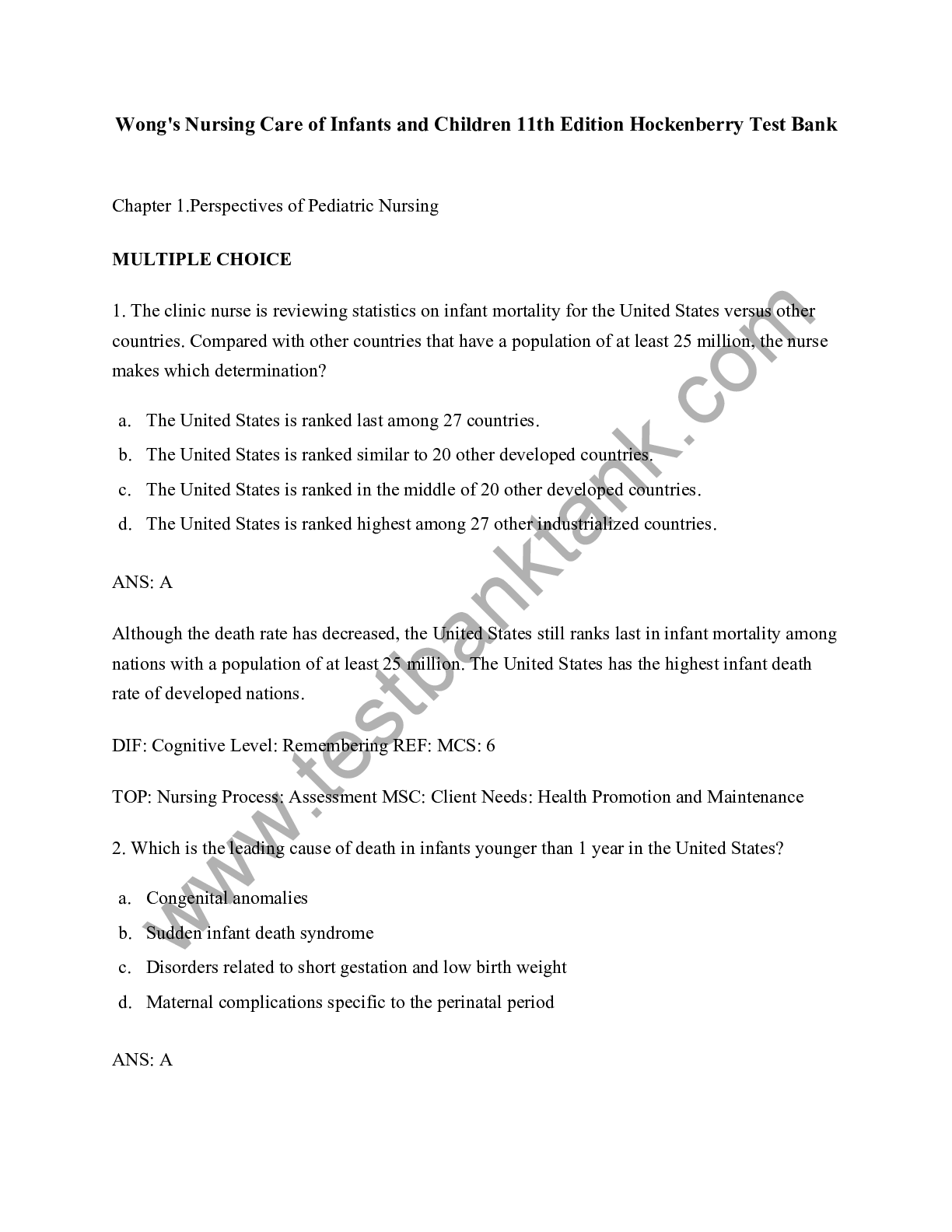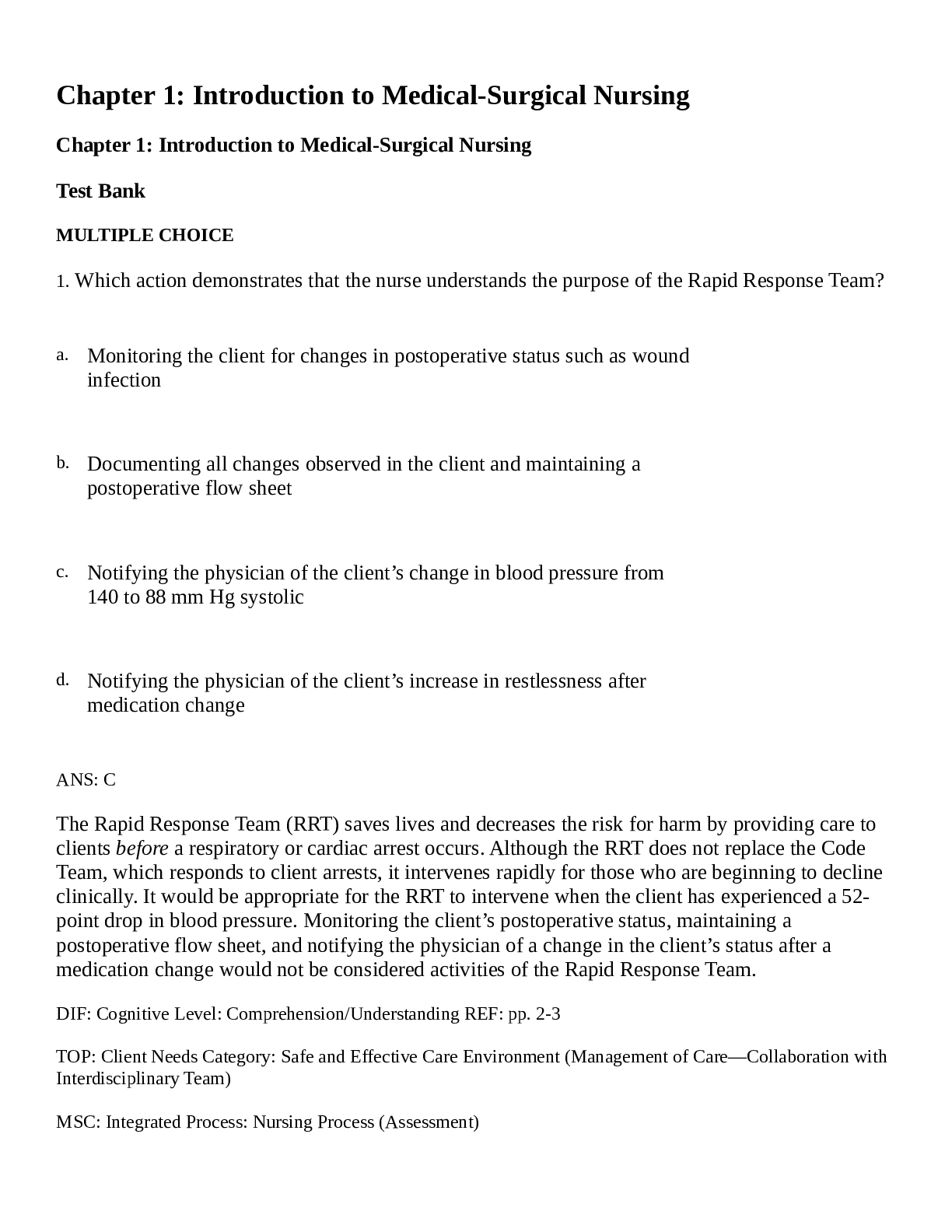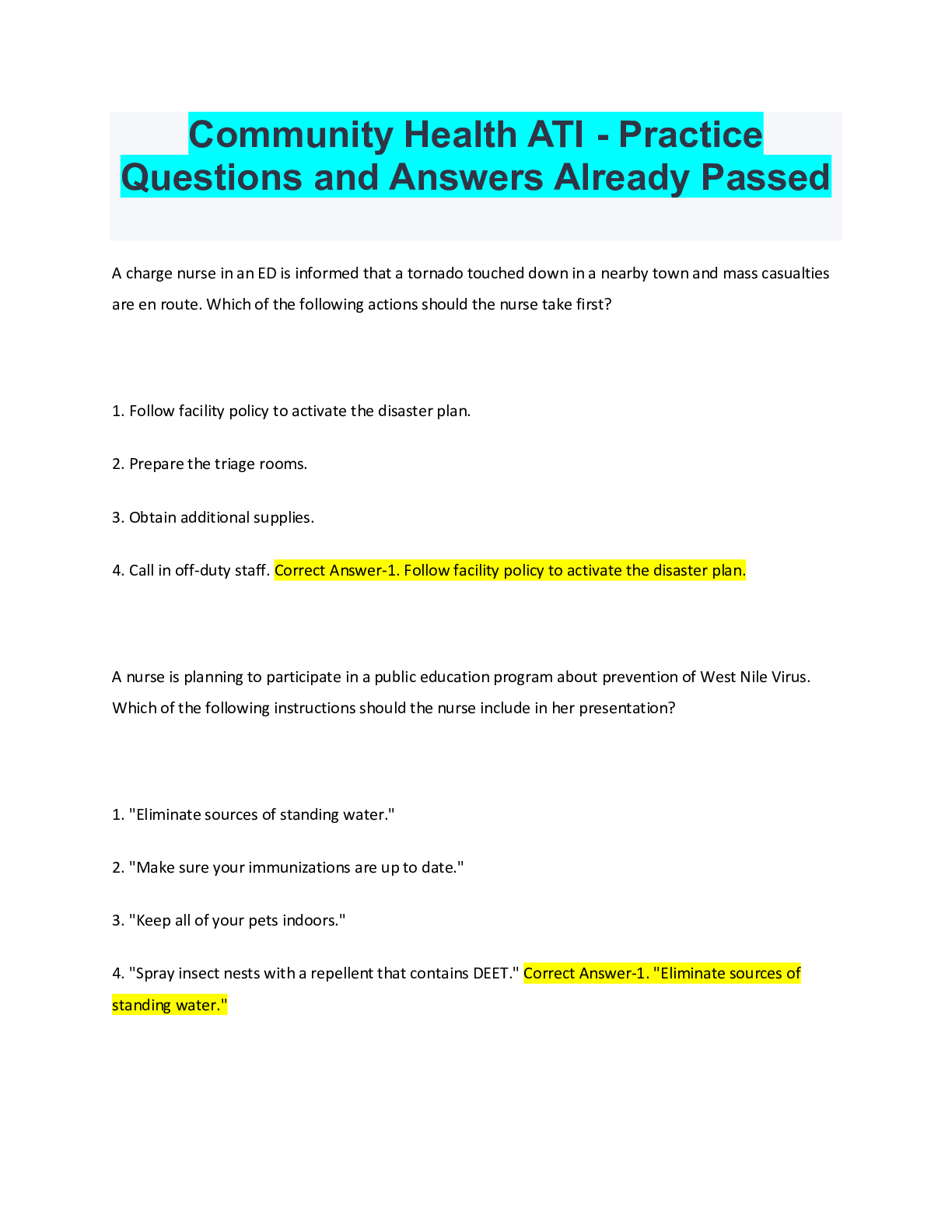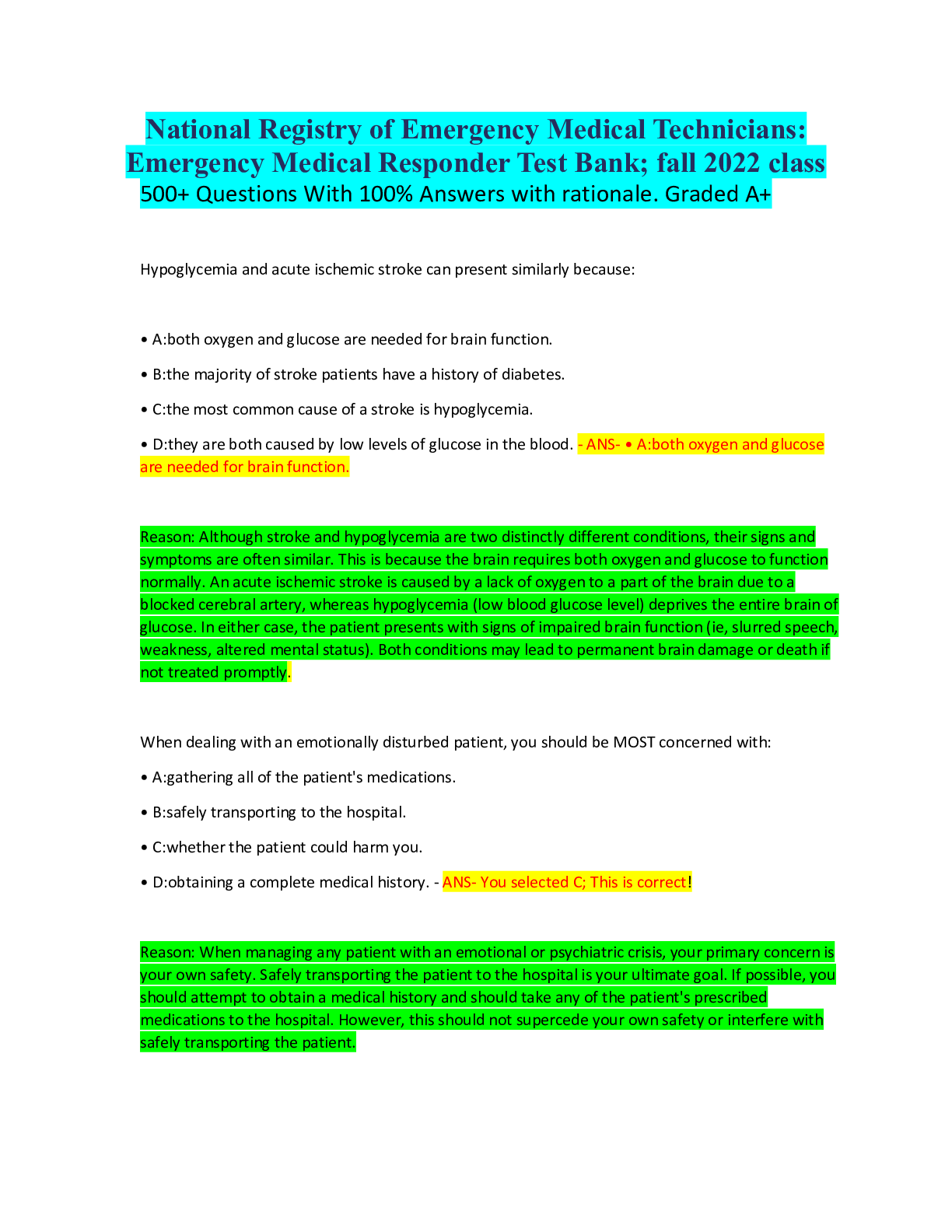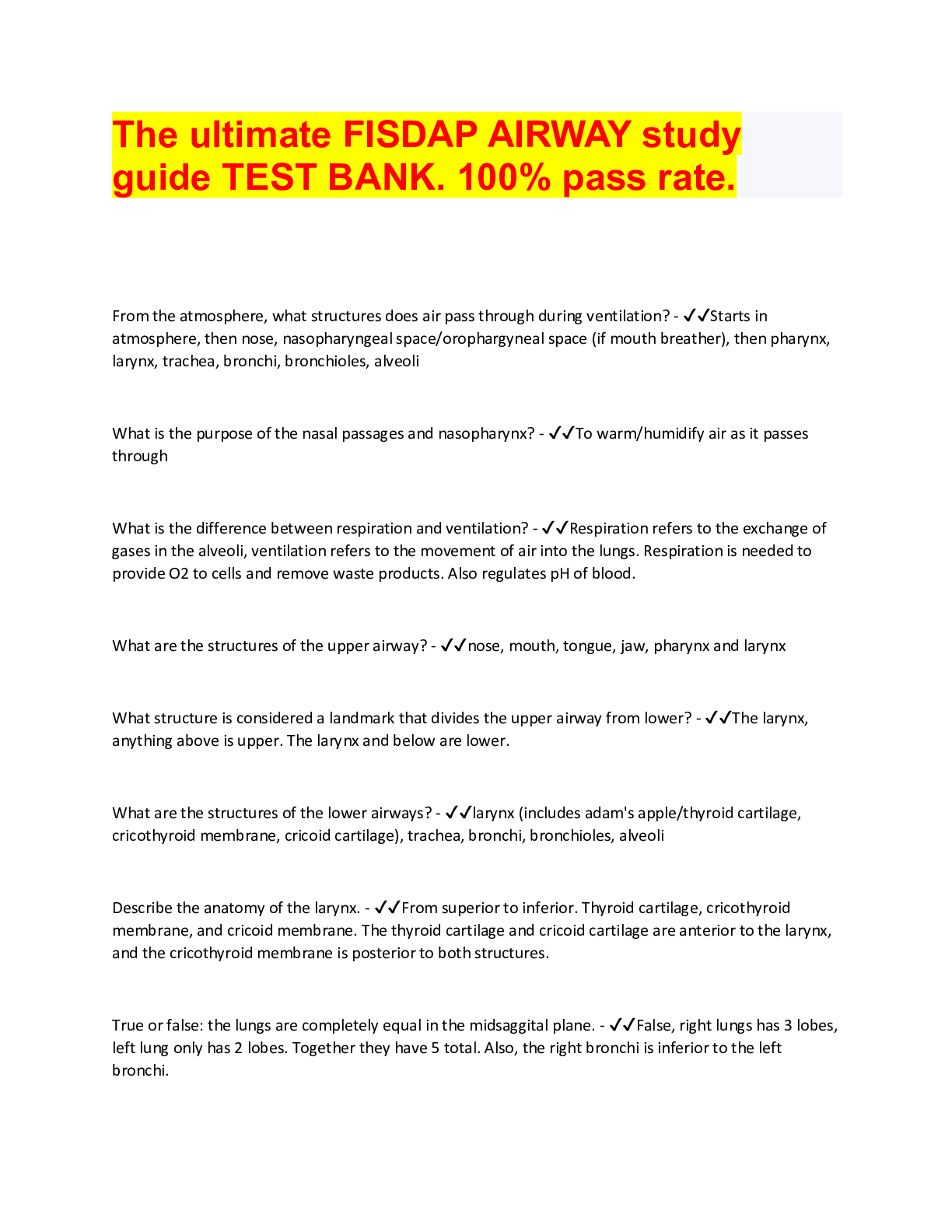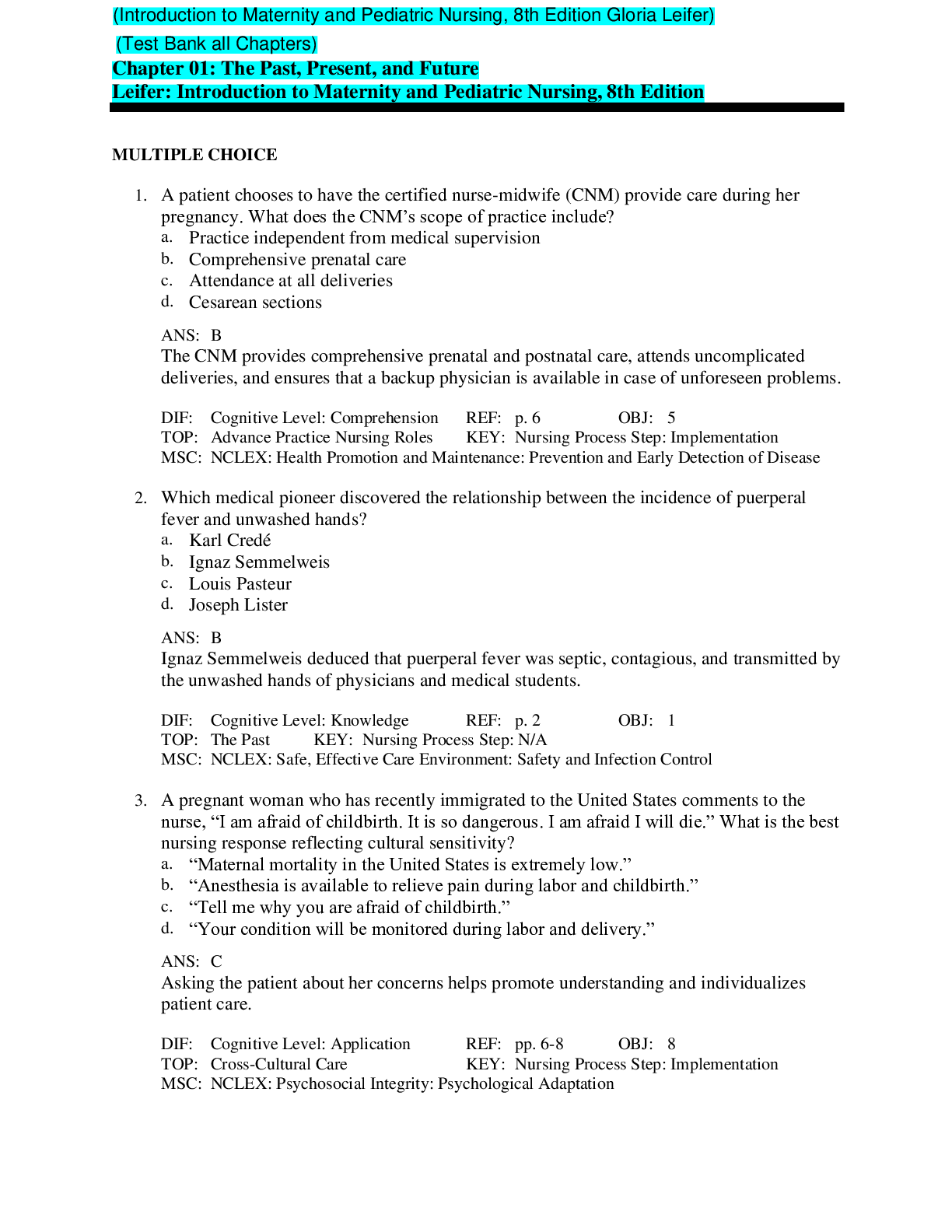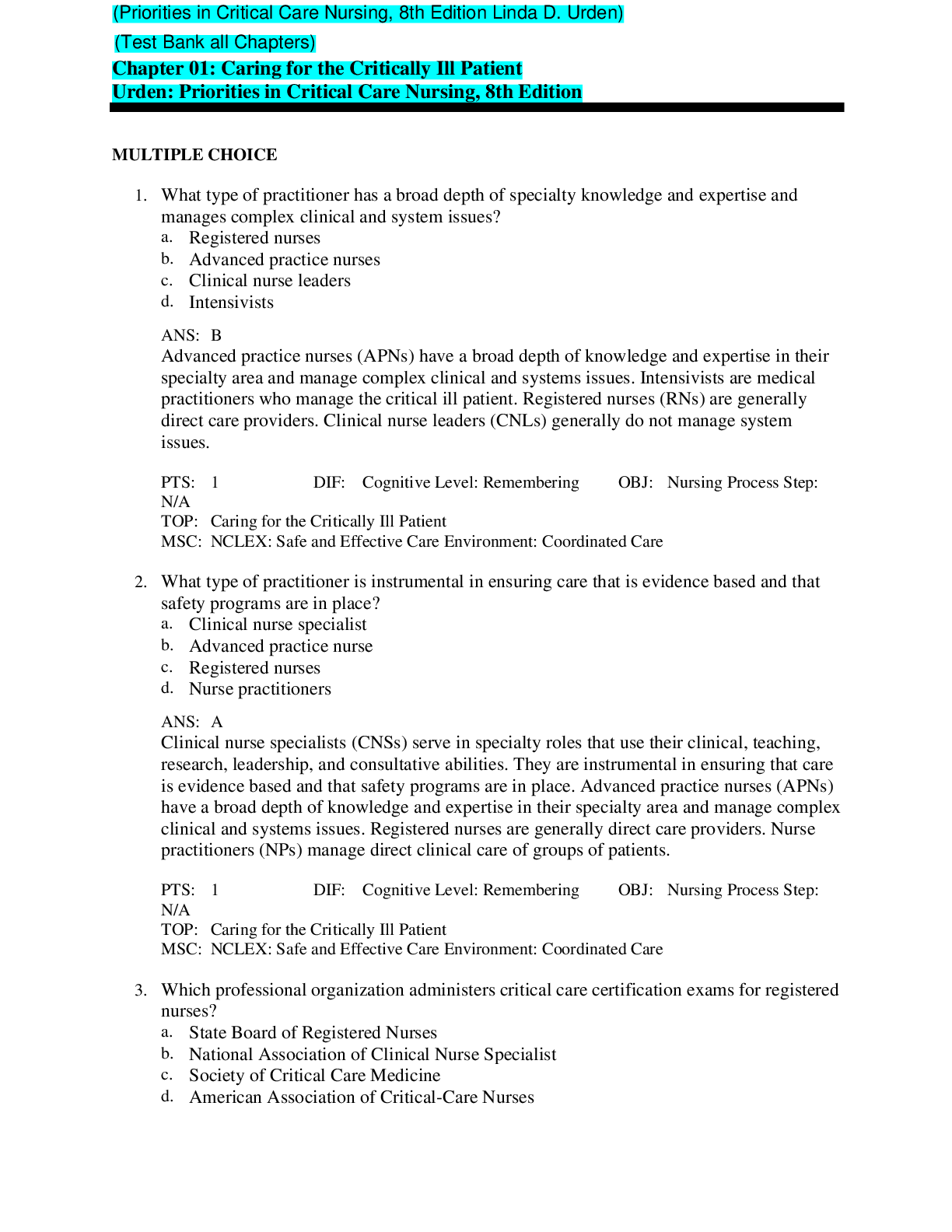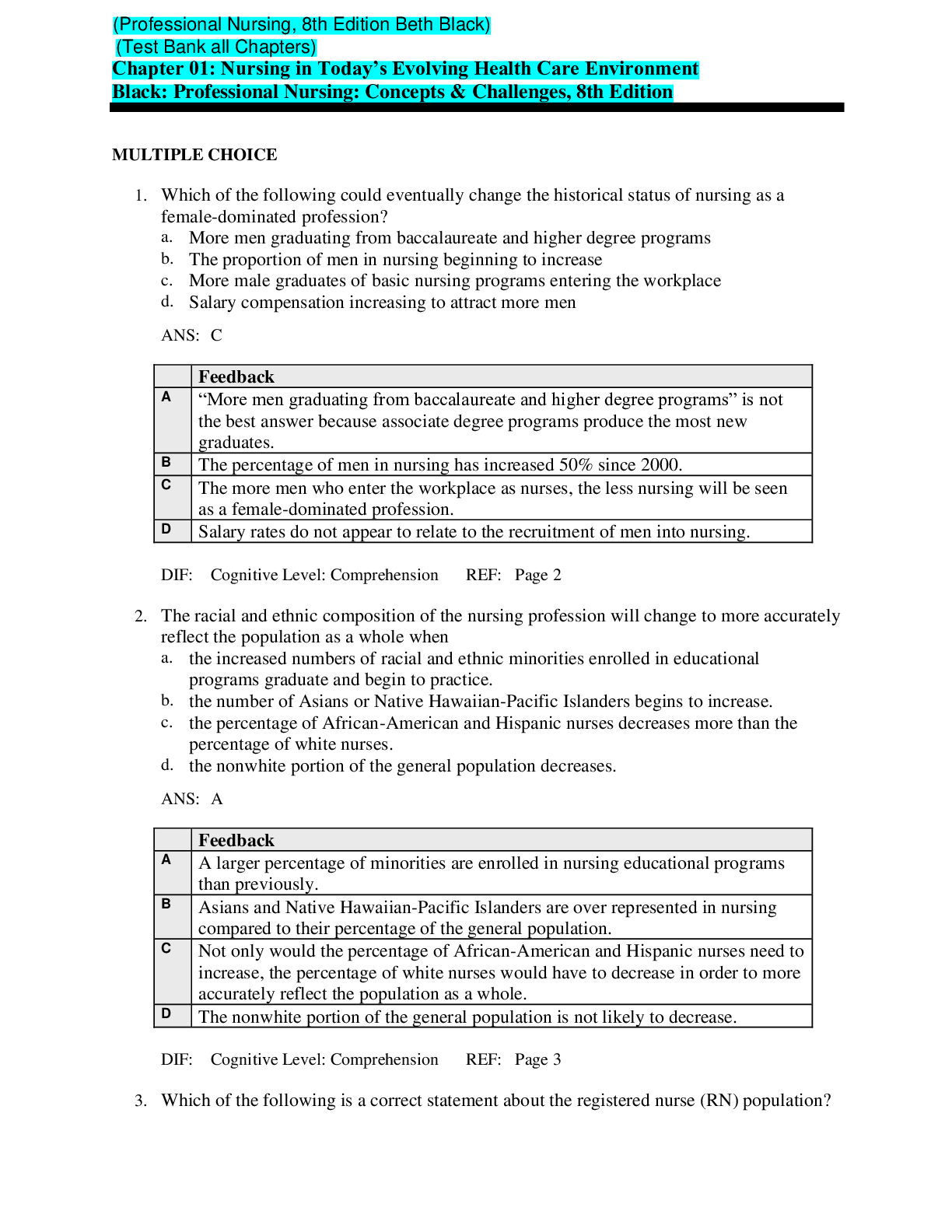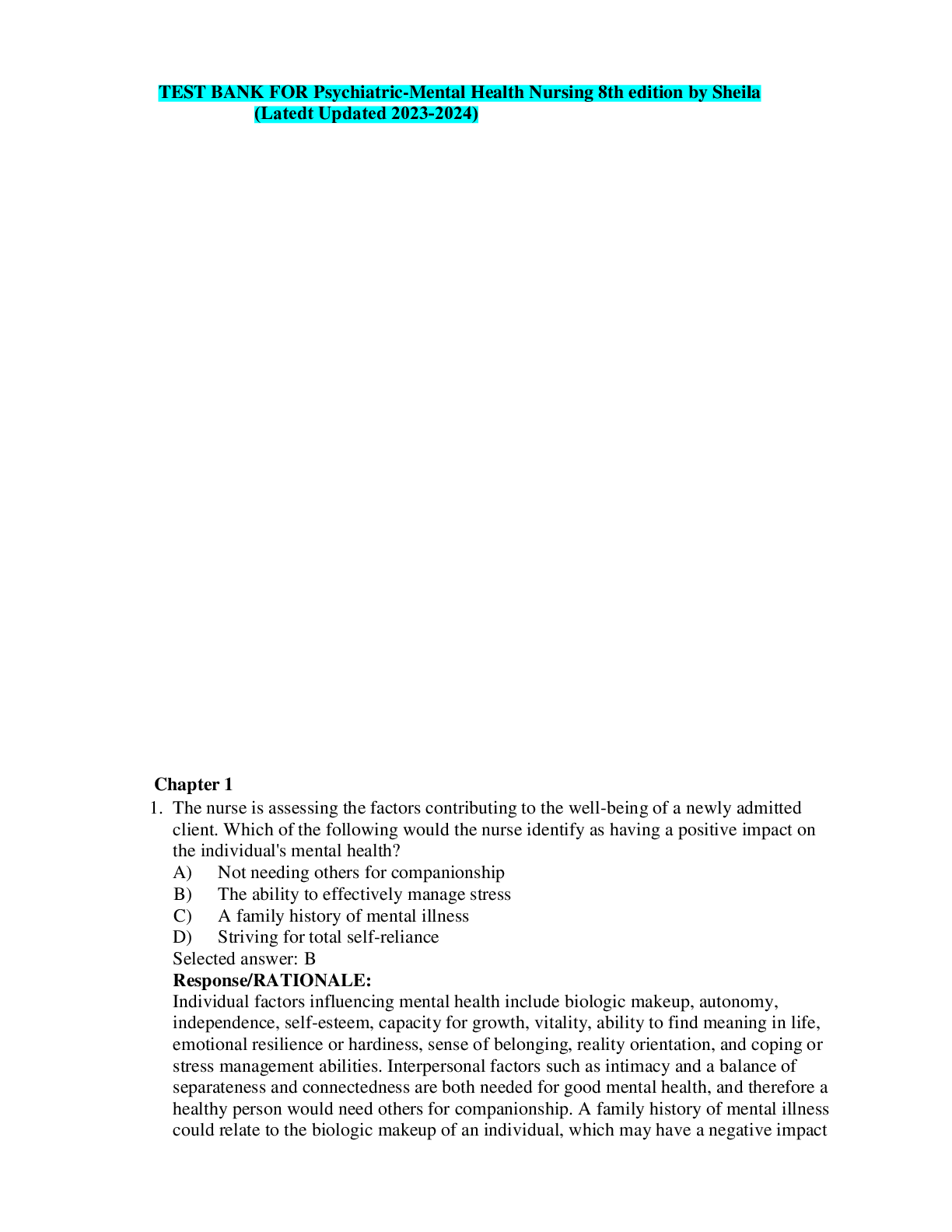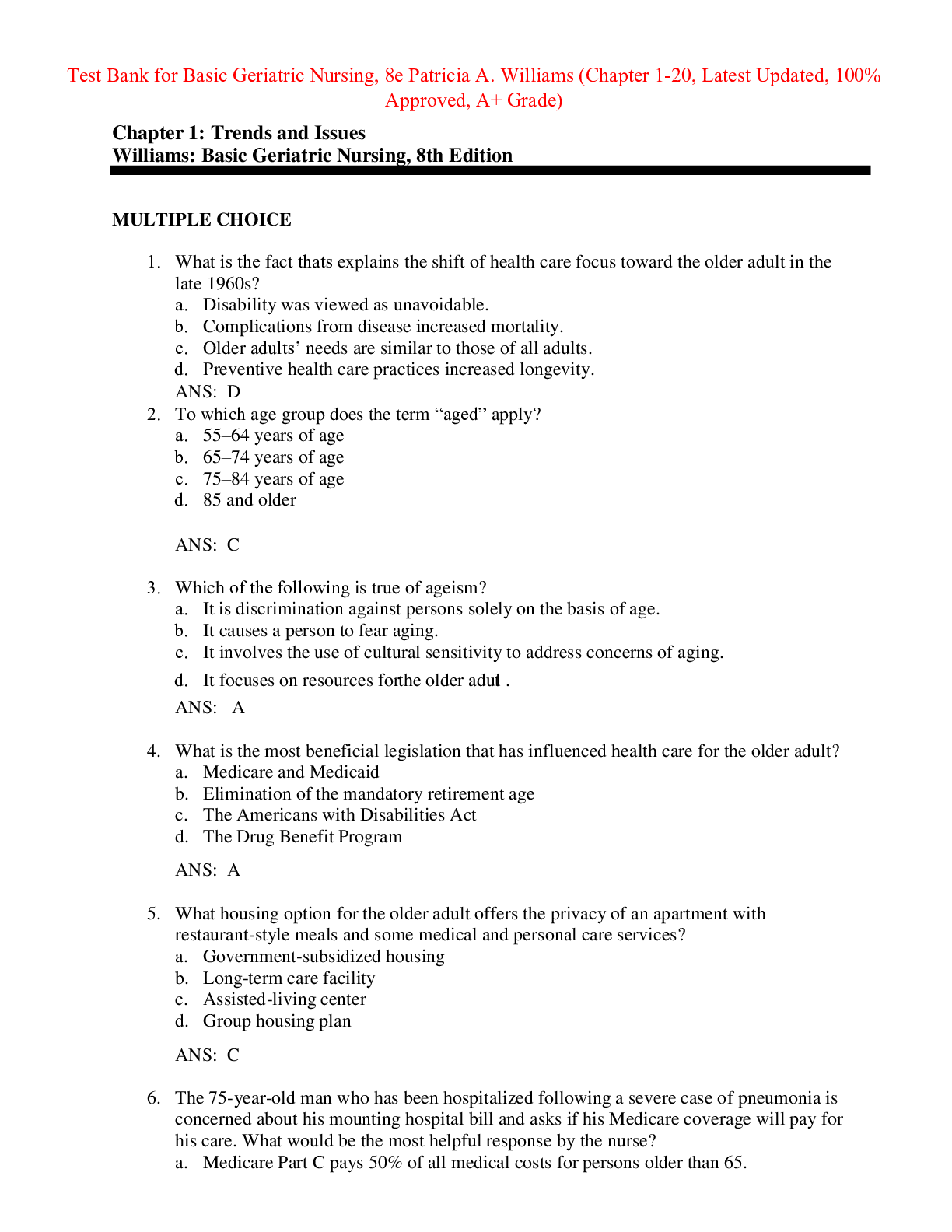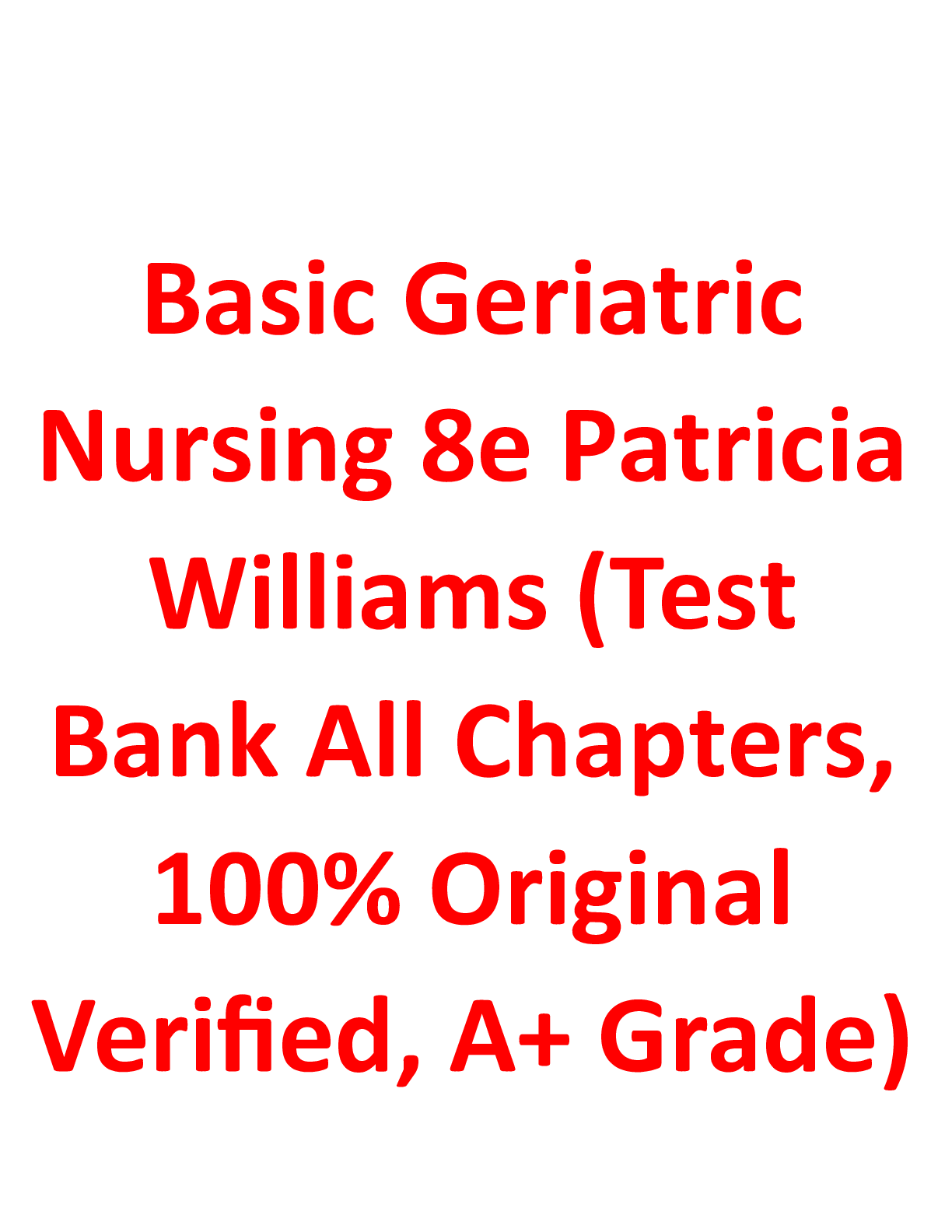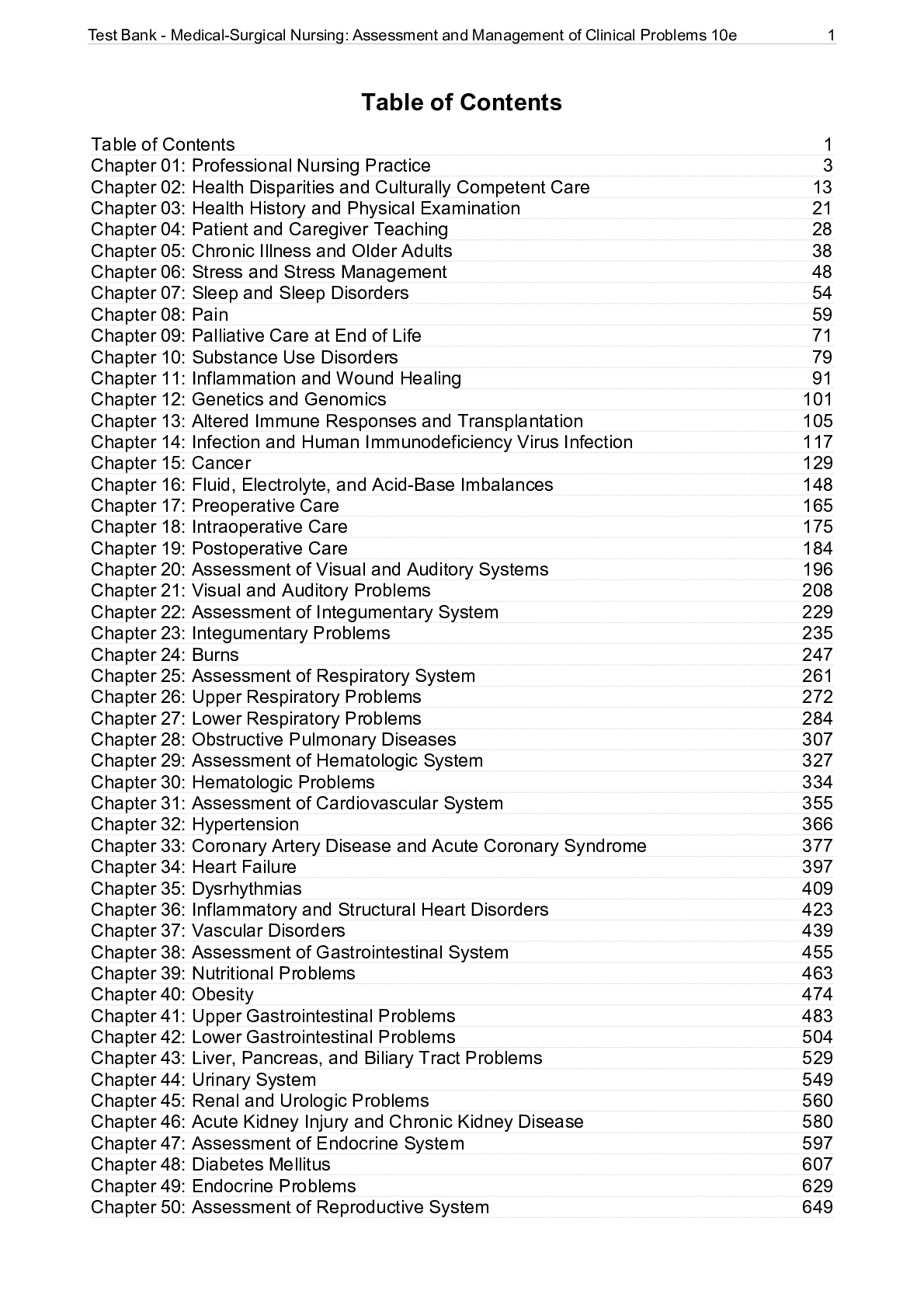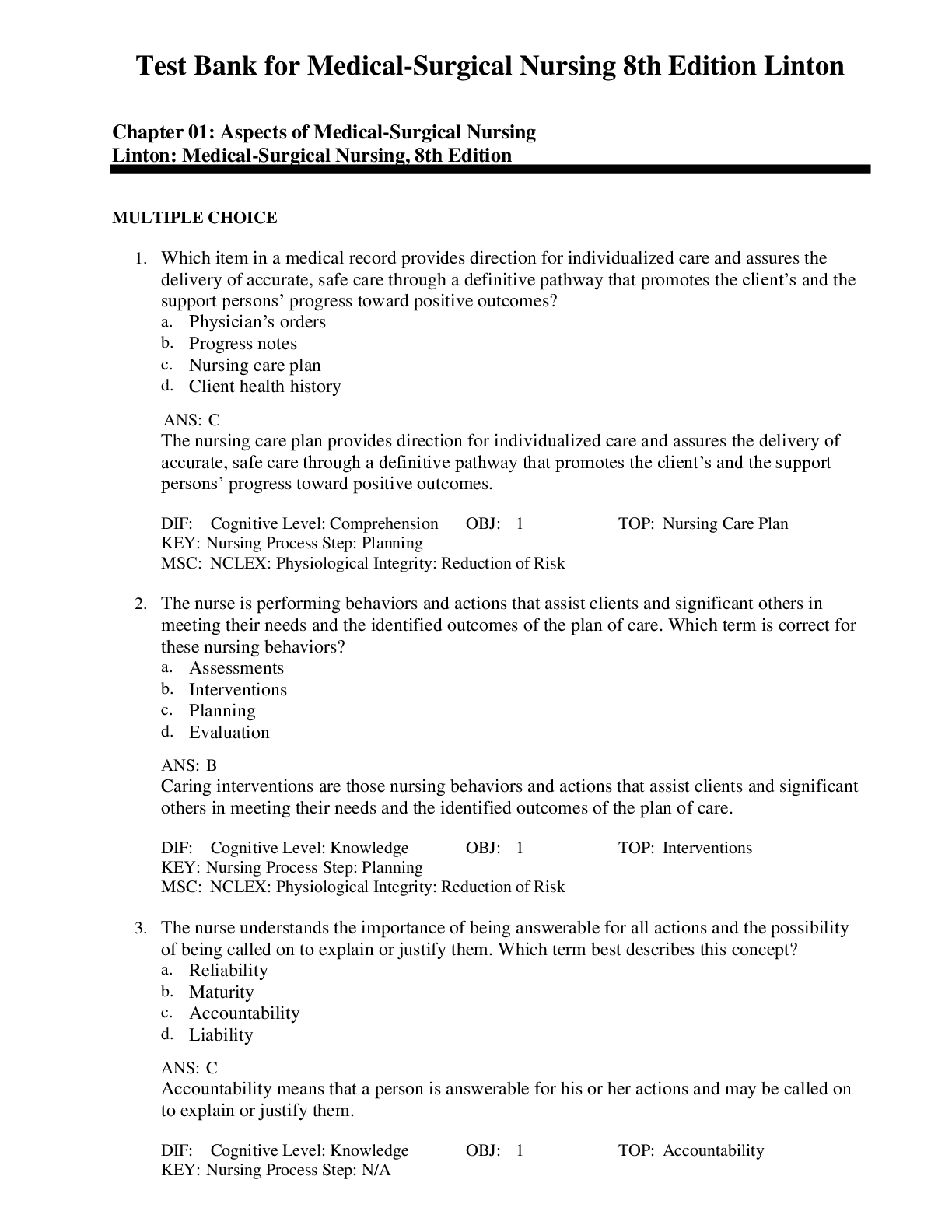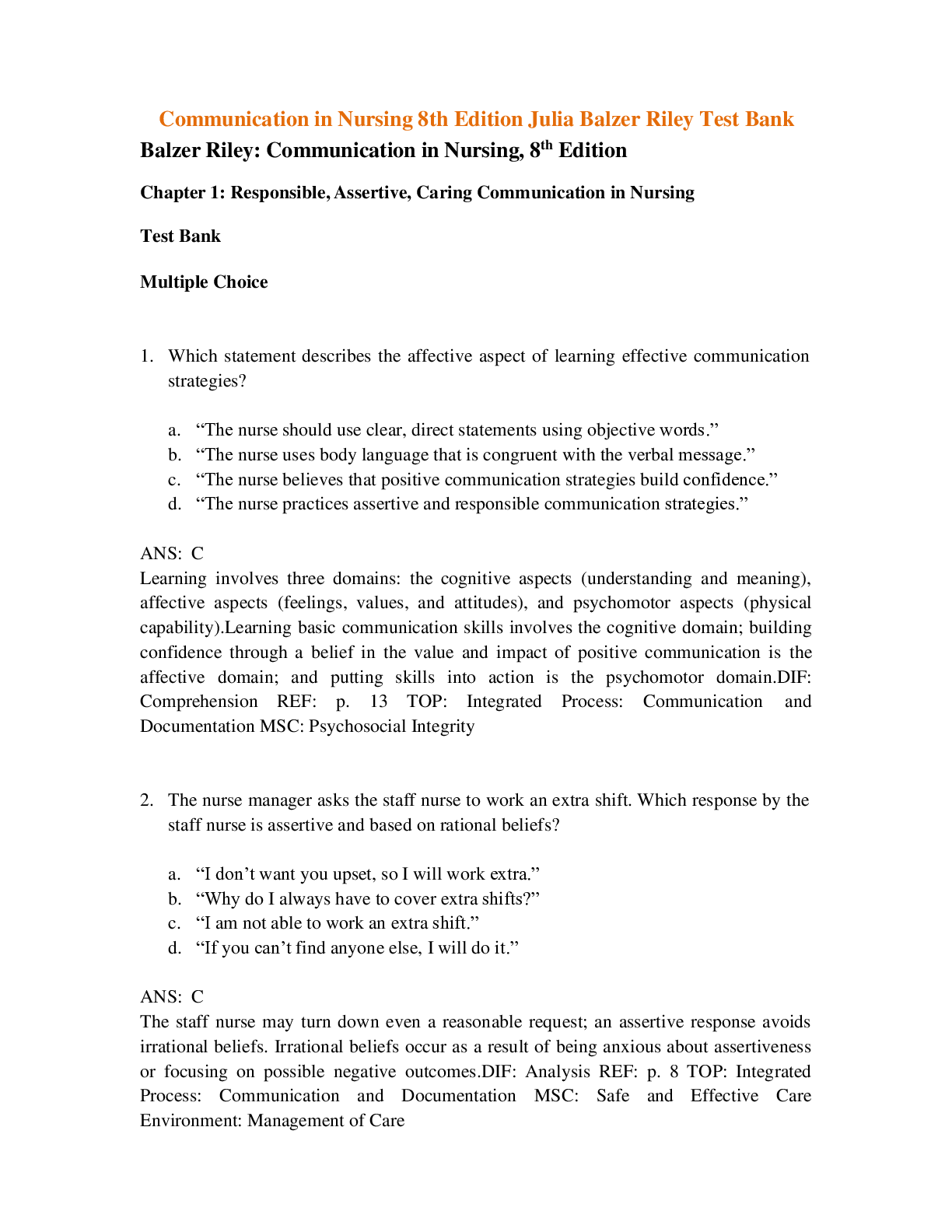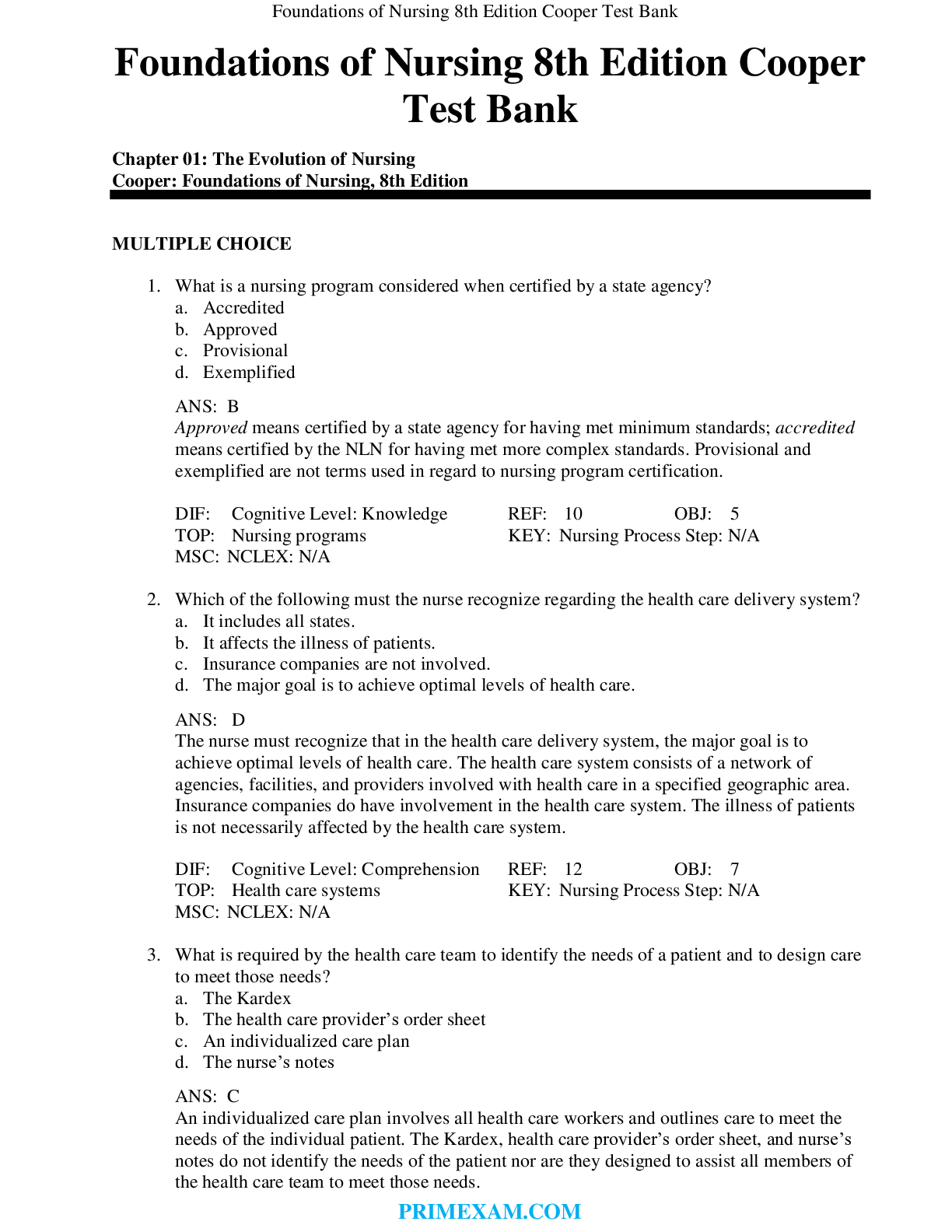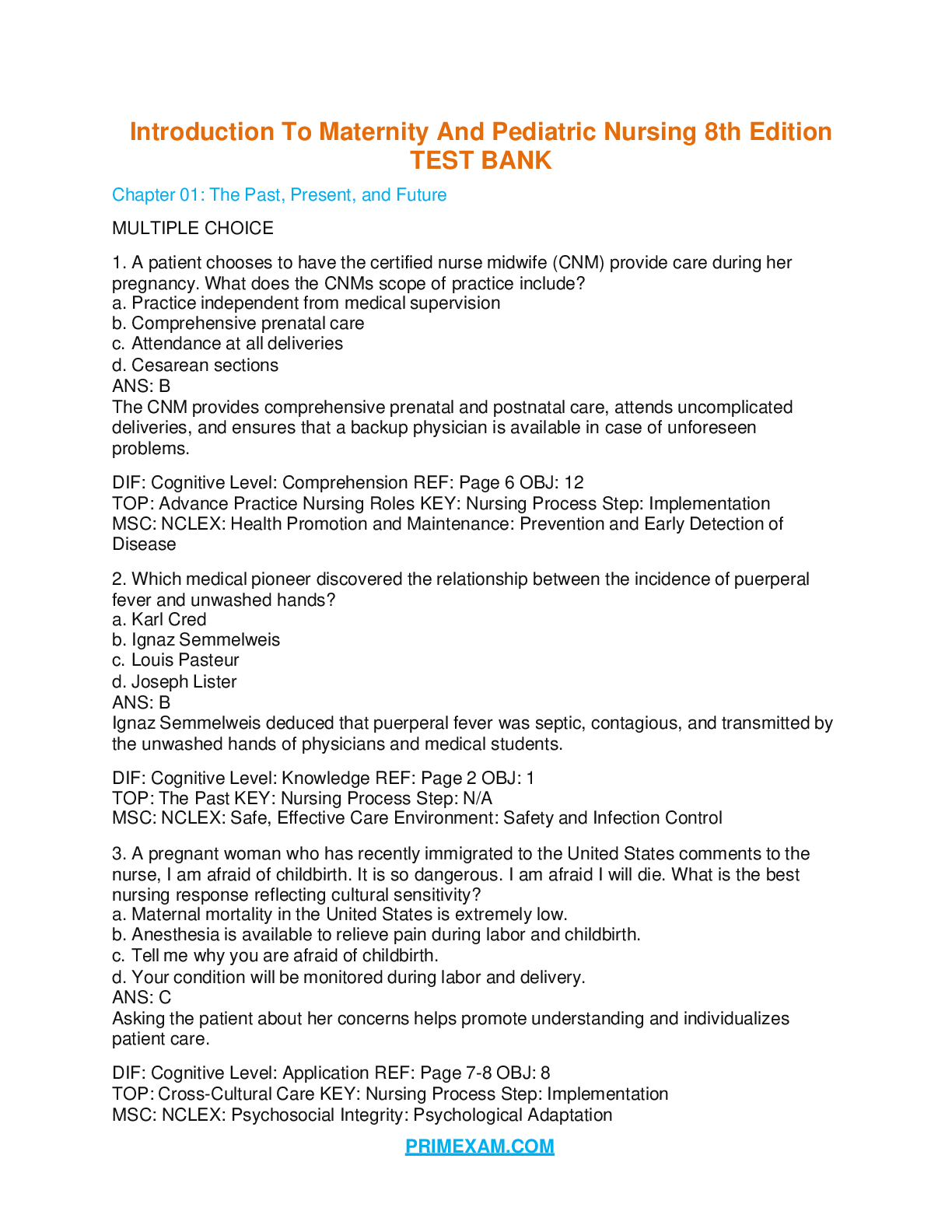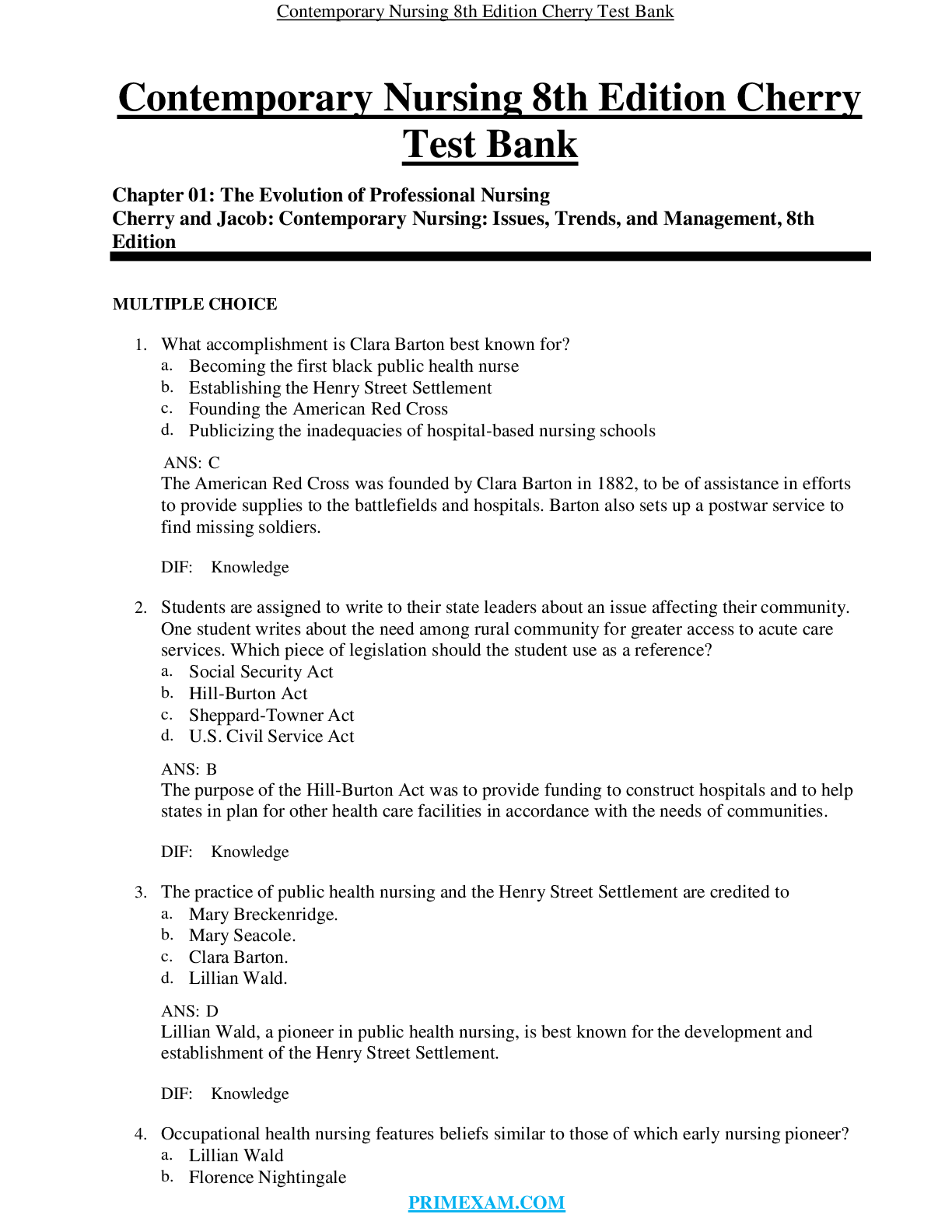*NURSING > TEST BANK > Essentials of Psychiatric Mental Health Nursing 8th Edition Concepts of Care in (All)
Essentials of Psychiatric Mental Health Nursing 8th Edition Concepts of Care in
Document Content and Description Below
Essentials of Psychiatric Mental Health Nursing 8th Edition Concepts of Care in Evidence - Based Practice 8th Edition Morgan Townsend Chapter 1. Mental Health and Mental Illness Multiple Choice ... 1. A nurse is assessing a client who is experiencing occasional feelings of sadness because of the recent death of a beloved pet. The clients appetite, sleep patterns, and daily routine have not changed. How should the nurse interpret the clients behaviors? 1.The clients behaviors demonstrate mental illness in the form of depression. 2.The clients behaviors are extensive, which indicates the presence of mental illness. 3.The clients behaviors are not congruent with cultural norms. 4.The clients behaviors demonstrate no functional impairment, indicating no mental illness. ANS: 4 Rationale: The nurse should assess that the clients daily functioning is not impaired. The client who experiences feelings of sadness after the loss of a pet is responding within normal expectations. Without significant impairment, the clients distress does not indicate a mental illness. Cognitive Level: Analysis Integrated Process: Assessment 2. At what point should the nurse determine that a client is at risk for developing a mental illness? 1.When thoughts, feelings, and behaviors are not reflective of the DSM-5 criteria.lOMoARcPSD|7906827 2.When maladaptive responses to stress are coupled with interference in daily functioning. 3.When a client communicates significant distress. 4.When a client uses defense mechanisms as ego protection. ANS: 2 Rationale: The nurse should determine that the client is at risk for mental illness when responses to stress are maladaptive and interfere with daily functioning. The DSM-5 indicates that in order to be diagnosed with a mental illness, daily functioning must be significantly impaired. The clients ability to communicate distress would be considered a positive attribute. Cognitive Level: Application Integrated Process: Assessment 3. A nurse is assessing a set of 15-year-old identical twins who respond very differently to stress. One twin becomes anxious and irritable, and the other withdraws and cries. How should the nurse explain these different stress responses to the parents? 1.Reactions to stress are relative rather than absolute; individual responses to stress vary. 2.It is abnormal for identical twins to react differently to similar stressors. 3.Identical twins should share the same temperament and respond similarly to stress. 4.Environmental influences to stress weigh more heavily than genetic influences.lOMoARcPSD|7906827 ANS: 1 Rationale: The nurse should explain to the parents that, although the twins have identical DNA, there are several other factors that affect reactions to stress. Mental health is a state of being that is relative to the individual client. Environmental influences and temperament can affect stress reactions. Cognitive Level: Application Integrated Process: Implementation 4. Which client should the nurse anticipate to be most receptive to psychiatric treatment? 1.A Jewish, female social worker. 2.A Baptist, homeless male. 3.A Catholic, black male. 4.A Protestant, Swedish business executive. ANS: 1 Rationale: The nurse should anticipate that the client of Jewish culture would place a high importance on preventative health care and would consider mental health as equally important as physical health. Women are also more likely to seek treatment for mental health problems than men. Cognitive Level: Application Integrated Process: Planning 5.A psychiatric nurse intern states, This clients use of defense mechanisms should be eliminated. Which is a correct evaluation of this nurses statement? 1.Defense mechanisms can be appropriate responses to stress and need not be eliminated. 2.Defense mechanisms are a maladaptive attempt of the ego to manage anxiety and should always be eliminated. 3.Defense mechanisms, used by individuals with weak ego integrity, should be discouraged and not eliminated.lOMoARcPSD|7906827 ANS: 1 4.Defense mechanisms cause disintegration of the ego and should be fostered and encouraged. ANS: 1 Rationale: The nurse should determine that defense mechanisms can be appropriate during times of stress. The client with no defense mechanisms may have a lower tolerance for stress, thus leading to anxiety disorders. Defense mechanisms should be confronted when they impede the client from developing healthy coping skills. Cognitive Level: Application Integrated Process: Evaluation 6. During an intake assessment, a nurse asks both physiological and psychosocial questions. The client angrily responds, Im here for my heart, not my head problems. Which is the nurses best response? 1.Its just a routine part of our assessment. All clients are asked these same questions. 2.Why are you concerned about these types of questions? 3.Psychological factors, like excessive stress, have been found to affect medical conditions. 4.We can skip these questions, if you like. It isnt imperative that we complete this section.lOMoARcPSD|7906827 ANS: 3 Rationale: The nurse should attempt to educate the client on the negative effects of excessive stress on medical conditions. It is not appropriate to skip physiological and psychosocial questions, as this would lead to an inaccurate assessment. Cognitive Level: Application Integrated Process: Implementation 7. An employee uses the defense mechanism of displacement when the boss openly disagrees with suggestions. What behavior would be expected from this employee? 1.The employee assertively confronts the boss. 2.The employee leaves the staff meeting to work out in the gym. 3.The employee criticizes a coworker. 4.The employee takes the boss out to lunch. ANS: 3 Rationale: The nurse should expect that the client using the defense mechanism displacement would criticize a coworker after being confronted by the boss. Displacement refers to transferring feelings from one target to a neutral or less-threatening target. Cognitive Level: Analysis Integrated Process: Assessment 8. A fourth-grade boy teases and makes jokes about a cute girl in his class. This behavior should be identified by a nurse as indicative of which defense mechanism? 1.Displacement 2.Projection 3.Reaction formationlOMoARcPSD|7906827 4.Sublimation ANS: 3 Rationale: The nurse should identify that the boy is using reaction formation as a defense mechanism. Reaction formation is the attempt to prevent undesirable thoughts from being expressed by expressing opposite thoughts or behaviors. Displacement refers to transferring feelings from one target to another. Rationalization refers to making excuses to justify behavior. Projection refers to the attribution of unacceptable feelings or behaviors to another person. Sublimation refers to channeling unacceptable drives or impulses into more constructive, acceptable activities. Cognitive Level: Application Integrated Process: Assessment 9. Which nursing statement about the concept of neurosis is most accurate? 1.An individual experiencing neurosis is unaware that he or she is experiencing distress. 2.An individual experiencing neurosis feels helpless to change his or her situation. 3.An individual experiencing neurosis is aware of psychological causes of his or her behavior. 4.An individual experiencing neurosis has a loss of contact with reality. ANS: 2 Rationale: The nurse should define the concept of neurosis with the following characteristics:The client feels helpless to change his or her situation, the client is aware that he or she is experiencing distress, the client is aware the behaviors are maladaptive, the client is unaware of the psychological causes of the distress, and the client experiences no loss of contact with reality. Cognitive Level: Application Integrated Process: Assessment 10. Which nursing statement regarding the concept of psychosis is most accurate? 1.Individuals experiencing psychoses are aware that their behaviors are maladaptive. 2.Individuals experiencing psychoses experience little distress. 3.Individuals experiencing psychoses are aware of experiencing psychological problems. 4.Individuals experiencing psychoses are based in reality. ANS: 2 Rationale: The nurse should understand that the client with psychosis experiences little distress owing to his or her lack of awareness of reality. The client with psychosis is unaware that his or her behavior is maladaptive or that he or she has a psychological problem. Cognitive Level: Application Integrated Process: Assessment 11. When under stress, a client routinely uses alcohol to excess. Finding her drunk, her husband yells at the client about her chronic alcohol abuse. Which action alerts the nurse to the clients use of the defense mechanism of denial? 1.The client hides liquor bottles in a closet.2.The client yells at her son for slouching in his chair. 3.The client burns dinner on purpose. 4.The client says to the spouse, I dont drink too much! ANS: 4 Rationale: The clients statement I dont drink too much! alerts the nurse to the use of the defense mechanism of denial. The client is refusing to acknowledge the existence of a real situation and the feelings associated with it. Cognitive Level: Application Integrated Process: Assessment 12. Devastated by a divorce from an abusive husband, a wife completes grief counseling. Which statement by the wife should indicate to a nurse that the client is in the acceptance stage of grief? 1.If only we could have tried again, things might have worked out. 2.I am so mad that the children and I had to put up with him as long as we did. 3.Yes, it was a difficult relationship, but I think I have learned from the experience. 4.I still dont have any appetite and continue to lose weight. ANS: 3 Rationale: The nurse should evaluate that the client is in the acceptance stage of grief because during this stage of the grief process, the client would be able to focus on the reality of the loss and its meaning in relation to life.Cognitive Level: Analysis Integrated Process: Evaluation 13. A nurse is performing a mental health assessment on an adult client. According to Maslows hierarchy of needs, which client action would demonstrate the highest achievement in terms of mental health?1. Maintaining a long-term, faithful, intimate relationship.2. Achieving a sense of self-confidence.3. Possessing a feeling of self-fulfillment and realizing full potential.4. Developing a sense of purpose and the ability to direct activities. ANS: 3 Rationale: The nurse should identify that the client who possesses a feeling of self-fulfillment and realizes his or her full potential has achieved selfactualization, the highest level on Maslows hierarchy of needs. Cognitive Level: Application Integrated Process: Assessment 14. According to Maslows hierarchy of needs, which situation on an inpatient psychiatric unit would require priority intervention by a nurse?1. A client rudely complaining about limited visiting hours.2. A client exhibiting aggressive behavior toward another client.3. A client stating that no one cares. 4. A client verbalizing feelings of failure. ANS: 2 Rationale: The nurse should immediately intervene when a client exhibits aggressive behavior toward another client. Safety and security are considered lower-level needs according to Maslows hierarchy of needs and must be fulfilled before other higher-level needs can be met. Clientswho complain, have feelings of failure, or state that no one cares are struggling with higher-level needs such as the need for love and belonging or the need for self-esteem. Cognitive Level: Analysis Integrated Process: Evaluation 15. How would a nurse best complete the new DSM-5 definition of a mental disorder? A health condition characterized by significant dysfunction in an individuals cognitions, or behaviors that reflects a disturbance in the 1.psychosocial, biological, or developmental process underlying mental functioning. 2.psychological, cognitive, or developmental process underlying mental functioning. 3.psychological, biological, or developmental process underlying mental functioning. 4.psychological, biological, or psychosocial process underlying mental functioning. ANS: 3 Rationale: A health condition characterized by significant dysfunction in an individuals cognitions, or behaviors that reflects a disturbance in the psychological, biological, or developmental process underlying mental functioning, is the new DSM 5 definition of a mental disorder. Cognitive Level: Application Integrated Process: Assessment Multiple Response16. A nurse is assessing a client who appears to be experiencing some anxiety during questioning. Which symptoms might the client demonstrate that would indicate anxiety? (Select all that apply.) 1.Fidgeting 2.Laughing inappropriately 3.Palpitations 4.Nail biting 5.Limited attention span ANS: 1, 2, 4 Rationale: The nurse should assess that fidgeting, laughing inappropriately, and nail biting are indicative of heightened stress levels. The client would not be diagnosed with mental illness unless there is significant impairment in other areas of daily functioning. Other indicators of more serious anxiety are restlessness, difficulty concentrating, muscle tension, and sleep disturbance. Cognitive Level: Application Integrated Process: Assessment Fill-in-the-Blank 17. is a diffuse apprehension that is vague in nature and is associated with feelings of uncertainty and helplessness. ANS: Anxiety Rationale: The definition of anxiety is a diffuse apprehension that is vague in nature and is associated with feelings of uncertainty and helplessness. Townsend considers this a core concept.Cognitive Level: Application Integrated Process: Assessment 18. is a subjective state of emotional, physical, and social responses to the loss of a valued entity. ANS: Grief Rationale: The definition of grief is a subjective state of emotional, physical, and social responses to the loss of a valued entity. Townsend considers this a core concept. Chapter 2. Biological Implications Multiple Choice 1.A depressed client states, I have a chemical imbalance in my brain. I have no control over my behavior. Medications are my only hope to feel normal again. Which nursing response is appropriate?1. Medications only address biological factors. Environmental and interpersonal factors must also be considered.2. Because biological factors are the sole cause of depression, medications will improve your mood.3. Environmental factors have been shown to exert the most influence in the development of depression.4. Researchers have been unable to demonstratea link between nature (biology and genetics) and nurture (environment). ANS: 1 Rationale: The nurse should advise the client that medications address biological factors, but there are other factors that affect mood. The nurse should educate the client on environmental and interpersonal factors that can lead to depression. Cognitive Level: Analysis Integrated Process: Implementation 2.A client diagnosed with major depressive disorder asks, What part of my brain controls my emotions? Which nursing response is appropriate? 1. The occipital lobe governs perceptions, judging them as positive or negative.2. The parietal lobe has been linked to depression.3. The medulla regulates key biological and psychological activities.4. The limbic system is largely responsible for ones emotional state. ANS: 4 Rationale: The nurse should explain to the client that the limbic system is largely responsible for ones emotional state. This system if often called the emotional brain and is associated with feelings, sexuality, and social behavior. The occipital lobes are the area of visual reception and interpretation. Somatosensory input (touch, taste, temperature, etc.) occurs in the parietal lobes. The medulla contains vital centers that regulate heart rate and reflexes. Cognitive Level: Application Integrated Process: Implementation 3.Which part of the nervous system should a nurse identify as playing a major role during stressful situations?1. Peripheral nervous system 2. Somatic nervous system 3. Sympathetic nervous system 4. Parasympathetic nervous system ANS: 3 Rationale: The nurse should identify that the sympathetic nervous system plays a major role during stressful situations. The sympathetic nervous system prepares the body for the fight-or- flight response. The parasympathetic nervous system is dominant when an individual is in a nonstressful state. Cognitive Level: Comprehension Integrated Process: Assessment 4. Which client statement reflects an understanding of circadian rhythms in psychopathology?1. When I dream about my mothers horrible train accident, I become hysterical. 2. I get really irritable during my menstrual cycle.3. Im a morning person. I get my best work done before noon. 4.Every February, I tend to experience periods of sadness. ANS: 3 Rationale: By stating, I am a morning person, the client demonstrates an understanding that circadian rhythms may influence a variety of regulatory functions, including the sleep-wake cycle, regulation of body temperature, and patterns of activity. Most humans follow a 24-hour cycle that is largely affected by lightness and darkness. Cognitive Level: Analysis Integrated Process: Evaluation5.Which types of adoption studies should a nurse recognize as providing useful information for the psychiatric community? 1. Studies in which children with mentally ill biological parents are raised by adoptive parents who were mentally healthy.2. Studies in which children with mentally healthy biological parents are raised by adoptive parents who were mentally ill. 3. Studies in which monozygotic twins from mentally ill parents were raised separately by different adoptive parents.4. Studies in which monozygotic twins were raised together by mentally ill biological parents. 5.All of the above. ANS: 5 Rationale: The nurse should determine that all of the studies could possibly benefit the psychiatric community. The studies may reveal research findings relating genetic links to mental illness. Adoption studies allow comparisons to be made of the influences of the environment versus genetics. Cognitive Level: Analysis Integrated Process: Evaluation 6.Six months after her husband and children were killed in a car accident, a client is diagnosed with ulcerative colitis. The nurse should recognize that this situation validates which study perspective? 1. Neuroendocrinology 2. Psychoimmunology3. Diagnostic technology4. Neurophysiology ANS: 2 Rationale: Psychoimmunology is the branch of medicine that studies the effects of social and psychological factors on the functioning of the immune system. Studies of the biological response to stress hypothesize that individuals become more susceptible to physical illness following exposure to stressful stimuli.Cognitive Level: Application Integrated Process: Evaluation 7. A withdrawn client, diagnosed with schizophrenia, expresses little emotion and refuses to attend group therapy. What altered component of the nervous system should a nurse recognize as being responsible for this behavior? 1. Dendrites2. Axons3. Neurotransmitters4. Synapses ANS: 3 Rationale: The nurse should recognize that neurotransmitters play an essential function in the role of human emotion and behavior. Neurotransmitters are targeted and affected by many psychotropic medications. Cognitive Level: Comprehension Integrated Process: Evaluation 8.An instructor is teaching nursing students about neurotransmitters. Which best explains the process of how neurotransmitters released into the synaptic cleft may return to the presynaptic neuron?1. Regeneration2. Reuptake3. Recycling4. Retransmission ANS: 2 Rationale: The nursing instructor should explain that the process by which neurotransmitters are released into the synaptic cleft and returned to the presynaptic neuron is termed reuptake. Reuptake is the process by which neurotransmitters are stored for reuse.Cognitive Level: Comprehension Integrated Process: Implementation 9.A nurse concludes that a restless, agitated client is manifesting a fightor-flight response. The nurse should associate this response with which neurotransmitter?1. Acetylcholine2. Dopamine3. Serotonin4. Norepinephrine ANS: 4 Rationale: The nurse should associate the neurotransmitter norepinephrine with the fight-or- flight response. Norepinephrine produces activity in the sympathetic postsynaptic nerve terminal and is associated with the regulation of mood, cognition, perception, locomotion, and sleep and arousal. Cognitive Level: Comprehension Integrated Process: Assessment 10. A client is admitted to a psychiatric unit with the diagnosis of catatonic schizophrenia. Which of the clients neurotransmitters should a nurse expect to be elevated?1. Serotonin 2.Dopamine 3.Gamma-aminobutyric acid (GABA) 4.Histamine ANS: 2 Rationale: The nurse should expect that elevated dopamine levels might be an attributing factor to the clients current level of functioning. Dopamine functions include regulation of movements and coordination, emotions, and voluntary decision-making ability.Cognitive Level: Application Integrated Process: Assessment 11. A clients wife of 34 years dies unexpectedly. The client cries often and becomes socially isolated. The clients therapist encourages open discussion of feelings, proper nutrition, and exercise. What is the best rationale for the therapists recommendations? 1. The therapist is using an interpersonal approach.2. The client has an alteration in neurotransmitters. 3. It is routine practice to remind clients about nutrition, exercise, and rest.4. The client is susceptible to illness because of effects of stress on the immune system. ANS: 4 Rationale: The therapists recommendations should be based on the knowledge that the client has been exposed to stressful stimuli and is at an increased risk to develop illness because of the effects of stress on the immune system. The study of this branch of medicine is called psychoimmunology. Cognitive Level: Application Integrated Process: Planning 12. Which mental illness should a nurse identify as being associated with a decrease in prolactin hormone level? 1. Major depressive episode2. Schizophrenia 3. Anorexia nervosa4. Alzheimers disease ANS: 2 Rationale: Although the exact mechanism is unknown, there may be some correlation between decreased levels of the hormone prolactin and schizophrenia.Cognitive Level: Application Integrated Process: Evaluation 13. Which cerebral structure should a nursing instructor describe to students as the emotional brain?1. The cerebellum2. The limbic system3. The cortex4. The left temporal lobe ANS: 2 Rationale: The limbic system is often referred to as the emotional brain. The limbic system is largely responsible for ones emotional state and is associated with feelings, sexuality, and social behavior. Cognitive Level: Comprehension Integrated Process: Implementation 14. A nurse understands that the abnormal secretion of growth hormone may play a role in which illness?1. Acute mania2. Schizophrenia3. Anorexia nervosa4. Alzheimers disease ANS: 3 Rationale: The nurse should understand that research has found a correlation between abnormal levels of growth hormone and anorexia nervosa. The growth hormone is responsible for growth in children, as well as continued protein synthesis throughout life. Cognitive Level: Comprehension Integrated Process: Assessment 15. A client is admitted to an emergency department experiencing memory deficits and decreased motor function. What alteration in brain chemistry should a nurse correlate with the production of thesesymptoms? 1. Abnormal levels of serotonin2. Decreased levels of dopamine3. Increased levels of norepinephrine 4. Decreased levels of acetylcholine ANS: 4 Rationale: The nurse should correlate memory deficits and decreased motor function with decreased levels of acetylcholine. Acetylcholine is a major effector chemical of the autonomic nervous system. Functions of acetylcholine include sleep regulation, pain perception, the modulation and coordination of movement, and memory. Cognitive Level: Application Integrated Process: Assessment 16. A nurse should recognize that a decrease in norepinephrine levels would play a significant role in which mental illness?1. Bipolar disorder: mania2. Schizophrenia spectrum disorder3. Generalized anxiety disorder4. Major depressive episode ANS: 4 Rationale: The nurse should recognize that a decrease in norepinephrine level would play a significant role in the development of major depressive disorder. The functions of norepinephrine include the regulation of mood, cognition, perception, locomotion, cardiovascular functioning, and sleep and arousal. Cognitive Level: Application Integrated Process: Evaluation 17. A nurse should expect that an increase in dopamine activity might play a significant role in the development of which mental illness?1. Schizophrenia spectrum disorder2. Major depressive disorder3. Body dysmorphic disorder4. Parkinsons diseaseANS: 1 Rationale: The nurse should expect that an increase in dopamine activity might play a significant role in the development of schizophrenia spectrum disorder. Functions of dopamine include regulation of emotions, coordination, and voluntary decision-making ability. Increased dopamine activity is also associated with mania. Cognitive Level: Application Integrated Process: Evaluation Multiple Response 18. Which of the following information should a nurse include when explaining causes of anorexia nervosa to a client? (Select all that apply.)1. There is a possible correlation between abnormal secretion of growth hormone and anorexia nervosa. 2. There is a possible correlation between antidiuretic hormone levels and anorexia nervosa. 3.There is a possible correlation between low levels of gonadotropin and anorexia nervosa. 4.There is a possible correlation between increased levels of prolactin and anorexia nervosa. 5.There is a possible correlation between altered levels of oxytocin and anorexia nervosa. ANS: 1, 3 Rationale: The nurse should explain to the client that there is a possible correlation between anorexia nervosa and decreased levels of growth hormones and gonadotropin. Anorexia nervosa has also been correlated with increased cortisol levels. Cognitive Level: Application Integrated Process: Implementation19. Which of the following symptoms should a nurse associate with the development of increased levels of thyroid-stimulating hormone (TSH) in a newly admitted client? (Select all that apply.)1. Depression2. Fatigue3. Increased libido4. Mania5. Hyperexcitability ANS: 1, 2 Rationale: The nurse should associate depression and fatigue with increased levels of TSH. TSH is only increased when thyroid levels are low, as in the diagnosis of hypothyroidism. In addition to depression and fatigue, other symptoms, such as decreased libido, memory impairment, and suicidal ideation are associated with chronic hypothyroidism. Cognitive Level: Application Integrated Process: Assessment Fill-in-the-Blank 20. is the study of the biological foundations of cognitive, emotional, and behavioral processes. ANS: Psychobiology Rationale: Psychobiology is the study of the biological foundations of cognitive, emotional, and behavioral processes. In recent years, a greater emphasis has been placed on the study of the organic basis for psychiatric illness.Chapter 3. Ethical and Legal Issues Multiple Choice 1. In response to a students question regarding choosing a psychiatric specialty, a charge nurse states, Mentally ill clients need special care. If I were in that position, Id want a caring nurse also. From which ethical framework is the charge nurse operating? 1.Kantianism 2.Christian ethics 3.Ethical egoism 4.Utilitarianism ANS: 2 Rationale: The charge nurse is operating from a Christian ethics framework. The imperative demand of Christian ethics is that all decisions about right and wrong should be centered in love for God and in treating others with the same respect and dignity with which we would expect to be treated. Kantianism states that decisions should be made based on moral law and that actions are bound by a sense of moral duty. Utilitarianism holds that decisions should be made focusing on the end result being happiness. Ethical egoism promotes the idea that what is right is good for the individual. Cognitive Level: Analysis Integrated Process: Assessment 2. During a hiring interview, which response by a nursing applicant should indicate that the applicant operates from an ethical egoism framework? 1.I would want to be treated in a caring manner if I were mentally ill.2.This job will pay the bills, and the workload is light enough for me. 3.I will be happy caring for the mentally ill. Working in med/surg kills my back. 4.It is my duty in life to be a psychiatric nurse. It is the right thing to do. ANS: 2 Rationale: The applicants comment reflects the ethical egoism framework. This framework promotes the idea that decisions are made based on what is good for the individual and may not take the needs of others into account. Cognitive Level: Analysis Integrated Process: Evaluation 3. Without authorization, a nurse administers an extra dose of narcotic tranquilizer to an agitated client. The nurses coworker observes this action but does nothing for fear of retaliation. What is the ethical interpretation of the coworkers lack of involvement? 1.Taking no action is still considered an unethical action by the coworker. 2.Taking no action releases the coworker from ethical responsibility. 3.Taking no action is advised when potential adverse consequences are foreseen. 4.Taking no action is acceptable, because the coworker is only a bystander. ANS: 1 Rationale: The coworkers lack of involvement can be interpreted as an unethical action. Thecoworker is experiencing an ethical dilemma in which a decision needs to be made between two unfavorable alternatives. The coworker has a responsibility to report any observed unethical actions. Cognitive Level: Analysis Integrated Process: Implementation 4. Group therapy is strongly encouraged, but not mandatory, in an inpatient psychiatric unit. The unit managers policy is that clients can make a choice about whether or not to attend group therapy. Which ethical principle does the unit managers policy preserve? 1.Justice 2.Autonomy 3.Veracity 4.Beneficence ANS: 2 Rationale: The unit managers policy regarding voluntary client participation in group therapy preserves the ethical principle of autonomy. The principle of autonomy presumes that individuals are capable of making independent decisions for themselves and that health-care workers must respect these decisions. Cognitive Level: Application Integrated Process: Implementation 5.Which is an example of an intentional tort? 1.A nurse fails to assess a clients obvious symptoms of neuroleptic malignant syndrome. 2.A nurse physically places an irritating client in four-point restraints. 3.A nurse makes a medication error and does not report the incident.4.A nurse gives patient information to an unauthorized person. ANS: 2 Rationale: A tort, which can be intentional or unintentional, is a violation of civil law in which an individual has been wronged. A nurse who intentionally physically places an irritating client in restraints has touched the client without consent and has committed an intentional tort. Cognitive Level: Application Integrated Process: Evaluation 6. An involuntarily committed client is verbally abusive to the staff, repeatedly threatening to sue. The client records the full names and phone numbers of the staff. Which nursing action is most appropriate to decrease the possibility of a lawsuit? 1.Verbally redirect the client, and then refuse one-on-one interaction. 2.Involve the hospitals security division as soon as possible. 3.Notify the client that documenting personal staff information is against hospital policy. 4.Continue professional attempts to establish a positive working relationship with the client. ANS: 4 Rationale: The most appropriate nursing action is to continue professional attempts to establish a positive working relationship with the client. The involuntarily committed client should be respected and has the right to assert grievances if rights are infringed.Cognitive Level: Analysis Integrated Process: Implementation 7. Which statement should a nurse identify as correct regarding a clients right to refuse treatment? 1.Clients can refuse pharmacological but not psychological treatment. 2.Clients can refuse any treatment at any time. 3.Clients can refuse only electroconvulsive therapy (ECT). 4.Professionals can override treatment refusal by an actively suicidal or homicidal client. ANS: 4 Rationale: The nurse should understand that health-care professionals could override treatment refusal when a client is actively suicidal or homicidal. A suicidal or homicidal client who refuses treatment may be in danger or a danger to others. This situation should be treated as an emergency, and treatment may be performed without informed consent. Cognitive Level: Application Integrated Process: Evaluation 8. Which potential client should a nurse identify as a candidate for involuntarily commitment? 1.The client living under a bridge in a cardboard box 2.The client threatening to commit suicide 3.The client who never bathes and wears a wool hat in the summer 4.The client who eats waste out of a garbage can ANS: 2Rationale: The nurse should identify the client threatening to commit suicide as eligible for involuntary commitment. The suicidal client who refuses treatments is in danger and needs emergency treatment. Cognitive Level: Application Integrated Process: Assessment 9. A client diagnosed with schizophrenia refuses to take medication, citing the right of autonomy. Under which circumstance would a nurse have the right to medicate the client against the clients wishes? 1.A client makes inappropriate sexual innuendos to a staff member. 2.A client constantly demands attention from the nurse by begging, Help me get better. 3.A client physically attacks another client after being confronted in group therapy. 4.A client refuses to bathe or perform hygienic activities. ANS: 3 Rationale: The nurse would have the right to medicate a client against his or her wishes if the client physically attacks another client. This client poses a significant risk to safety and is incapable of making informed choices. The clients refusal to accept treatment can be challenged, because the client is endangering the safety of others. Cognitive Level: Application Integrated Process: Implementation10. A psychiatric nurse working on an inpatient unit receives a call asking if an individual has been a client in the facility. Which nursing response reflects appropriate legal and ethical obligations? 1.The nurse refuses to give any information to the caller, citing rules of confidentiality. 2.The nurse hangs up on the caller. 3.The nurse confirms that the person has been at the facility but adds no additional information. 4.The nurse suggests that the caller speak to the clients therapist. ANS: 1 Rationale: The most appropriate action by the nurse is to refuse to give any information to the caller. Admission to the facility would be considered protected health information (PHI) and should not be disclosed by the nurse without prior client consent. Cognitive Level: Application Integrated Process: Implementation 11. A client requests information on several medications in order to make an informed choice about management of depression. A nurse should provide this information to facilitate which ethical principle? 1.Autonomy 2.Beneficence 3.Nonmaleficence 4.Justice ANS: 1 Rationale: The nurse should provide the information to support the clients autonomy. A client who is capable of making independent choices should be permitted to do so. In instances when clients are incapable of makinginformed decisions, a legal guardian or representative would be asked to give consent. Cognitive Level: Application Integrated Process: Implementation 12. An inpatient psychiatric physician refuses to treat clients without insurance and prematurely discharges those whose insurance benefits have expired. Which ethical principle should a nurse determine has been violated based on these actions? 1.Autonomy 2.Beneficence 3.Nonmaleficence 4.Justice ANS: 4 Rationale: The nurse should determine that the ethical principle of justice has been violated by the physicians actions. The principle of justice requires that individuals should be treated equally, regardless of race, sex, marital status, medical diagnosis, social standing, economic level, or religious belief. Cognitive Level: Application Integrated Process: Evaluation13. Which situation reflects violation of the ethical principle of veracity? 1.A nurse discusses with a client another clients impending discharge. 2.A nurse refuses to give information to a physician who is not responsible for the clients care. 3.A nurse tricks a client into seclusion by asking the client to carry linen to the seclusion room. 4.A nurse does not treat all of the clients equally, regardless of illness severity. ANS: 3 Rationale: The nurse who tricks a client into seclusion has violated the ethical principle of veracity. The principle of veracity refers to ones duty to always be truthful and not intentionally deceive or mislead clients. Cognitive Level: Application Integrated Process: Implementation 14. A client who will be receiving electroconvulsive therapy (ECT) must provide informed consent. Which situation should cause a nurse to question the validity of the informed consent? 1.The client is paranoid. 2.The client is 87 years old. 3.The client incorrectly reports his or her spouses name, date, and time of day. 4.The client relies on his or her spouse to interpret the information. ANS: 3 Rationale: The nurse should question the validity of informed consent when the client incorrectly reports the spouses name, date, and time of day. This indicates that this client is disoriented and may not be competent to make informed choices.Cognitive Level: Application Integrated Process: Assessment 15. A client diagnosed with schizophrenia receives fluphenazine decanoate (Prolixin Decanoate) from a home health nurse. The client refuses medication at one regularly scheduled home visit. Which nursing intervention is ethically appropriate? 1.Allow the client to decline the medication and document the decision. 2.Tell the client that if the medication is refused, hospitalization will occur. 3.Arrange with a relative to add the medication to the clients morning orange juice. 4.Call for help to hold the client down while the injection is administered. ANS: 1 Rationale: It is ethically appropriate for the nurse to allow the client to decline the medication and provide accurate documentation. The clients right to refuse treatment should be upheld, unless the refusal puts the client or others in harms way. Cognitive Level: Analysis Integrated Process: Implementation 16. Which situation exemplifies both assault and battery? 1.The nurse becomes angry, calls the client offensive names, and withholds treatment. 2.The nurse threatens to tie down the client and then does so, against the clients wishes. 3.The nurse hides the clients clothes and medicates the client to prevent elopement. 4.The nurse restrains the client without just cause and communicates this to family.ANS: 2 Rationale: The nurse in this situation has committed both the acts of assault and battery. Assault refers to an action that results in fear and apprehension that the person will be touched without consent. Battery is the touching of another person without consent. Cognitive Level: Analysis Integrated Process: Implementation 17. A geriatric client is confused and wandering in and out of every door. Which scenario reflects the least restrictive alternative for this client? 1.The client is placed in seclusion. 2.The client is placed in a geriatric chair with tray. 3.The client is placed in soft Posey restraints. 4.The client is monitored by an ankle bracelet. ANS: 4 Rationale: The least-restrictive alternative for this client would be monitoring by an ankle bracelet. The client does not pose a direct dangerous threat to self or others, so neither physical restraints nor seclusion would be justified. Cognitive Level: Application Integrated Process: Implementation 18. A brother calls to speak to his sister, who has been admitted to a psychiatric unit. The nurse connects him to the community phone, and the sister is summoned. Later the nurse realizes that the brother was not on the clients approved call list. What law has the nurse broken? 1.The National Alliance for the Mentally Ill Act 2.The Tarasoff Ruling3.The Health Insurance Portability and Accountability Act 4.The Good Samaritan Law ANS: 3 Rationale: The nurse has violated the Health Insurance Portability and Accountability Act (HIPAA) by revealing that the client had been admitted to the psychiatric unit. The nurse should not have provided any information without proper consent from the client. Cognitive Level: Application Integrated Process: Implementation Multiple Response 19. After disturbing the peace, an aggressive, disoriented, unkempt, homeless individual is escorted to an emergency department. The client threatens suicide. Which of the following criteria would enable a physician to consider involuntary commitment? (Select all that apply.) 1.Being dangerous to others 2.Being homeless 3.Being disruptive to the community 4.Being gravely disabled and unable to meet basic needs 5.Being suicidalANS: 1, 4, 5 Rationale: The physician could consider involuntary commitment when a client is dangerous to others, gravely disabled, or is suicidal. If the physician determines that the client is mentally incompetent, consent should be obtained from the legal guardian or court-approved guardian or conservator. A hospital administrator may give permission for involuntary commitment when time does not permit court intervention. Cognitive Level: Application Integrated Process: Assessment Fill-in-the-Blank 20. A valid, legally recognized claim or entitlement, encompassing both freedom from government interference or discriminatory treatment and an entitlement to a benefit or a service is defined as a . ANS: right Rationale: A right is a valid, legally recognized claim or entitlement, encompassing both freedom from government interference or discriminatory treatment and an entitlement to a benefit or a service. A right is absolute when there is no restriction whatsoever on the individuals entitlement. Cognitive Level: Application Integrated Process: Assessment 21. A branch of philosophy that addresses methods for determining the rightness or wrongness of ones actions is defined as .ANS: ethics Rationale: Ethics is a branch of philosophy that deals with systematic approaches to distinguishing right from wrong behavior. Bioethics is the term applied to these principles when they refer to concepts within the scope of medicine, nursing, and allied health. Chapter 4. Psychopharmacology MULTIPLE CHOICE 1.The nurse manager on the psychiatric unit was explaining to the new staff the differences between typical and atypical antipsychotics. The nurse correctly states that atypical antipsychotics: a. Remain in the system longer b. Act more quickly to reduce delusionsc. Produce fewer extrapyramidal effects d. Are risk free for neuroleptic malignant syndrome (NMS) ANS: C Atypical antipsychotics produce less D2 blockade; thus movement disorders are less of a problem. No evidence suggests that the medication remains in the system longer nor that it acts more quickly to reduce delusions. The atypicals are not risk free for NMS. 2.The nurse would assess for neuroleptic malignant syndrome (NMS) if a patient on haloperidol (Haldol) develops a: a. 30 mm Hg decrease in blood pressure reading b. Respiratory rate of 24 respirations per minute c. Temperature reading of 104 F d. Pulse rate of 70 beats per minute ANS: C Increased temperature is the cardinal sign of NMS. This BP is not a significant feature of NMS. There are no significant findings to support the options related to respirations or pulse rate. 3.A patient taking fluphenazine (Prolixin) complains of dry mouth and blurred vision. What would the nurse assess as the likely cause of these symptoms? a. Decreased dopamine at receptor sitesb. Blockade of histamine c. Cholinergic blockade d. Adrenergic blocking ANS: C Fluphenazine administration produces blockade of cholinergic receptors giving rise to anticholinergic effects, such as dry mouth, blurred vision, and constipation.4.Which behavior displayed by a patient receiving a typical antipsychotic medication would be assessed as displaying behaviors characteristic of tardive dyskinesia (TD)? a. Grimacing and lip smacking b. Falling asleep in the chair and refusing to eat lunch c. Experiencing muscle rigidity and tremors d. Having excessive salivation and drooling ANS: A TD manifests as abnormal movements of voluntary muscle groups after a prolonged period of dopamine blockade. Movements may affect any muscle group, but muscles of the face, mouth, tongue, and digits are commonly affected. Falling asleep is reflective of the sedative effect of these medications. Muscle rigidity and drooling reflect EPS caused from imbalance between dopamine and acetylcholine. 5.When the nurse realizes that a patient diagnosed with schizophrenia is not taking the prescribed oral haloperidol (Haldol), which intervention would promote medication compliance? a. Instructing the patient to have friends monitor his medications b. Beginning administration of haloperidol (Haldol) decanoate c. Writing instructions in detail for the patient to follow d. Changing haloperidol to an atypical antipsychotic ANS: BHaloperidol decanoate is a depot medication, given intramuscularly every 2 to 4 weeks. It is unknown whether the patient has a support system. The patient probably received education, including written instructions prior to discharge. Changing to another classification of medication would not necessarily improve compliance. 6.When asked how tricyclic antidepressants affect neurotransmitter activity, the nurse should respond that they:a. Decrease available dopamine. b. Increase availability of norepinephrine and serotonin. c. Make available increased amounts of monoamine oxidase. d. Increase the effects of the chemical gamma-aminobutyric acid. ANS: B Tricyclic antidepressants block neurotransmitter uptake, increasing the amounts of norepinephrine and serotonin available. Decreasing dopamine is the action of typical antipsychotic medication. Increasing monoamine oxidase is not the action of tricyclics. Benzodiazepines, not tricyclics, increase the effects of GABA. 7.A severely depressed patient has been prescribed clomipramine (Anafranil). For which medication side effects should the patient be monitored? a. Excess salivation and drooling b. Muscle rigidity and restlessness c. Polyuria and coarse hand tremors d. Orthostatic hypotension and constipation ANS: D Alpha1 blockade produces orthostatic hypotension, and cholinergic blockade produces constipation. Mild tremors and urinary retention may occur. Drooling and excessive salvation may occur with SSRIs. Muscle rigidity and restlessness may occur with antipsychotics.8.Which of these statements made by a patient taking the MAOI phenelzine (Nardil) would warrant further instruction? a. I often forget to wear sunscreen when I go outside. b. I need to restrict the amount of sodium in my diet. c. I should not use over-the-counter cold medications. d. I usually order liver and onions when my wife and I eat out.ANS: D MAOIs require patients to observe a tyramine-free diet to prevent hypertensive crisis. Liver is a food that contains large amounts of tyramine. The remaining options have no relevance for MAOI therapy. 9.Which patient complaint should receive priority from a patient who is taking the MAOI tranylcypromine (Parnate)? a. I havent had a bowel movement in 2 days. b. Will you take my temperature? I feel too warm. c. I get a headache when I drank several cups of coffee. d. My legs get stiff when I sit in the chair for any length of time. ANS: C Hypertensive crisis may occur if a patient taking a MAOI ingests certain food containing tyramine or drugs that cause blood pressure (BP) elevation. Headache is a warning sign of hypertensive crisis. The nurse should assess BP and inquire about other symptoms of hypertensive crisis. Stiffness is not related to MAOI therapy. Elevated temperature is not an initial sign of hypertensive crisis. Constipation is not a sign of hypertensive crisis. 10. Sertraline (Zoloft) has been prescribed for a patient with symptoms of a major depression. Which factor was probably most important in the physicians decision to use an SSRI?a. Good side-effect profile b. Less expense for the patient c. Increase in medication compliance d. Rapid rate of absorption from the GI tract ANS: ACompared to other antidepressant medication groups, SSRIs have the best side-effect profile. SSRIs are more costly. No studies have shown that SSRIs result in better compliance. These drugs are absorbed slowly from the GI tract. 11. Which statement made by a patient who will be maintained on lithium following discharge will require further instruction by the nurse? a. I will have my blood work done regularly. b. When I get home, I may go on a salt-free diet. c. I have learned not to restrict my intake of water. d. I understand some people gain weight on lithium. ANS: B This statement shows that the patient does not understand the relationship between lithium and sodium. The patient must be taught that changing dietary salt intake will affect lithium levels. Adding salt can cause lower levels; reducing salt can result in toxicity. The remaining options reflect correct information regarding lithium therapy. 12. To educate a patient regarding what to expect following the administration of a benzodiazepine, the nurse must understand that benzodiazepines: a. Have a rapid onset of peak action b. Reduce availability of GABAc. Generally diminish the activity of GABA d. Interact with serotonin to increase availability ANS: A Benzodiazepines do have a more rapid onset. There is no effect on the availability or function of GABA. Benzodiazepines do not diminish GABA activity; they enhance it.13. A patient prescribed alprazolam (Xanax) for symptoms of anxiety shares with the nurse that, Im concerned about getting off this medication. Upon which fact will the nurse base the response to the patients concern? a. Long elimination half-life will result in a manageable withdrawal treatment plan. b. Rapid absorption and distribution to brain cells make withdrawal more difficult to manage. c. Sensitivity of the mesencephalic reticular activating system makes addiction unlikely. d. The combination of medication with an antidepressant often positively impacts withdrawal. ANS: B In general, shorter-acting benzodiazepines are more difficult to taper and potentially cause more problems with withdrawal. The remaining options are neither true nor relevant. 14. Which patient outcomes would be most applicable for the patient who has been taking benzodiazepines? Patient will state: a. That there are specific foods to avoid while on this medication b. An understanding of how to increase medication dosage c. That alcohol is a substance to avoid while on the medication d. An understanding that he or she can return to work while on this medication ANS: CCombining a benzodiazepine with alcohol or other CNS depressant is potentially fatal. No food restrictions exist. Dosage should not be changed without consultation with the physician. Patients may return to work unless experiencing sedation. In this case, they would be cautioned not to operate machinery. 15. Which person with mania is the least likely candidate to receive lithium? The patient who is: a. Six weeks pregnantb. Recovering from a hysterectomy c. Taking hormone replacement therapy d. Displaying symptoms of postpartum depression ANS: A Lithium is contraindicated during pregnancy because of teratogenic effects. The remaining options would not be contraindicative to lithium therapy. 16. An individual with poststroke depression is receiving an SSRI. What is the rationale for giving the medication at breakfast and again at midday? a. Prevent insomnia b. Prevent toxic reactions c. Decrease afternoon sleepiness d. Give an opportunity to monitor behavior closely ANS: A CNS stimulants may cause insomnia if given late in the day. Toxicity is a result of excessive medication in the system, not when it is administered. The drowsiness resulting from SSRI use would not be minimized if taken as described. There is no expectation that resulting behaviors will need to be so closely monitored. 17. A patient who has received lithium for 3 weeks to control acute mania has the following symptoms: coarse hand tremor, diarrhea,vomiting, lethargy, and mild confusion. The priority nursing action should be to: a. Administer prn Cogentin to relieve the symptoms. b. Provide reassurance that the symptoms are transient. c. Obtain a stat lithium level; hold lithium pending results. d. Assist the patient to decrease the sodium in their daily diet. ANS: CThe symptoms the patient is experiencing are consistent with moderate lithium toxicity. The nurse should hold lithium, obtain a stat lithium level, and notify the physician. Cogentin is inappropriate; the symptoms are not EPS. The nurse may reassure the patient but cannot suggest that the symptoms will resolve over time. Minimizing salt would worsen lithium toxicity. 18. A patient with rapid cycling bipolar disorder is not responding well to lithium. The patient tells the nurse, It feels as though Ill never get well. I get better, and then I get worse. The reply that is based on knowledge of current therapy would be: a. Youre feeling very discouraged arent you? b. Its not all bad, is it? Sometimes you like being high. c. Another drug, valproic acid, is proving effective for rapid cycling. d. If your kidneys hold out, the lithium will eventually control the symptoms. ANS: C Valproic acid is a first-line agent for the treatment of bipolar disorder. It is particularly effective with rapid cycling. The other options are not responsive to the question stem, which asks for knowledge of current therapy. 19. Which statement by a patient with generalized anxiety disorder for whom lorazepam (Ativan) is prescribed as needed (prn) suggests the patient understands the purpose of the medication?a. I can talk with my therapist more easily after my medication takes effect. b. I wonder if I will have to take this medication for the rest of my entire life. c. Im embarrassed and dont want anyone to know Im on this kind of medication. d. Im going to ask for my prn dose so I can sleep instead of worrying about my kids. ANS: A The patient recognizes the therapeutic effects of the medication in assisting her to work effectively with the therapist. The remaining options show questions and inappropriate use of the medication.20. A patient has been taking chlorpromazine (Thorazine) for the past 2 weeks. He drools, has hand tremors, and walks with a shuffling gait. The nurse would correctly attribute these behaviors to: a. Akinesia b. Tardive dyskinesia c. Pseudoparkinsonism d. Neuroleptic malignant syndrome ANS: C These are symptoms of pseudoparkinsonism associated with dopamine blockade. Tardive dyskinesia occurs after long-term therapy. The remaining options are not associated with the symptoms mentioned. 21. What intervention will the nurse request for a patient reporting gastrointestinal side effects related to valproate therapy? a. Mild laxative b. Low-fat diet c. Oral antacid d. Histamine-2 antagonist ANS: D Indigestion, heartburn, and nausea are common side effects of valproate therapy. The administration of a histamine-2 antagonist such as famotidine(Pepcid) is sometimes helpful. The other options would have no impact on the complaint. 22. A patients serum lithium level is reported as 1.9 mEq/L. The nurse should immediately: a. Restrict sodium and fluid intake. b. Assess for signs and symptoms of toxicity. c. Seek to have the patient transferred to ICU.d. Notify the patients physician immediately. ANS: B A serum lithium level this high suggests that the patient may be experiencing symptoms of lithium toxicity. Clinical assessment is essential to determine what, if any, signs and symptoms are present. After the clinical assessment has been made, the nurse can provide the physician with a complete picture. Restricting sodium and fluids would raise the serum level. Transferring may not be necessary and would require a physicians order. 23. To evaluate outcomes for a patient with schizophrenia receiving typical antipsychotic drug therapy, the nurse would look for improvement in: a. Affective mobility b. Positive symptoms c. Self-care activities d. Cognitive functioning ANS: B Typical antipsychotic medications produce improvement in the positive symptoms of schizophrenia such as hallucinations and delusions. Negative symptoms and cognitive functioning tend to show less improvement.24. During a psychiatric emergency, IM ziprasidone (Geodon) is administered to an assaultive patient. During the next 2 hours, it is of primary importance that the nurse assess for: a. Tardive dyskinesia b. Anticholinergic effects c. Orthostatic hypotension d. Pseudoparkinso nism ANS: CThe side effect most likely to appear is orthostatic hypotension related to alpha1 receptor blockade preventing peripheral blood vessels from automatically responding to positional change. Anticholinergic effects are of lesser concern. The remaining options are less likely to occur at this point in therapy. 25. A patient who began haloperidol (Haldol) therapy 24 hours ago tells the nurse that he feels jittery and unable to sit or stand still. The nurse can hypothesize that this report is related to: a. Dystonia b. Akathisia c. Serotonin syndrome d. Neuroleptic malignant syndrome ANS: B Akathisia, an extrapyramidal side effect, is characterized by restlessness, inability to sit still, and the need to pace. It usually occurs early in the course of treatment with a typical antipsychotic drug. The symptomology is not related or seen in the other options. Chapter 5. Relationship Development and Therapeutic Communication Multiple Choice 1. What is the most essential task for a nurse to accomplish prior to forming a therapeutic relationship with a client? 1.Clarify personal attitudes, values, and beliefs.2.Obtain thorough assessment data. 3.Determine the clients length of stay. 4.Establish personal goals for the interaction. ANS: 1 Rationale: The most essential task for a nurse to accomplish prior to forming a therapeutic relationship with a client is to clarify personal attitudes, values, and beliefs. Understanding ones own attitudes, values, and beliefs is called self-awareness. Cognitive Level: Application Integrated Process: Implementation2. If a client demonstrates transference toward a nurse, how should the nurse respond? 1.Promote safety and immediately terminate the relationship with the client. 2.Encourage the client to ignore these thoughts and feelings. 3.Immediately reassign the client to another staff member. 4.Help the client to clarify the meaning of the relationship, based on the present situation. ANS: 4 Rationale: The nurse should respond to a clients transference by clarifying the meaning of the nurse-client relationship based on the present situation. Transference occurs when the client unconsciously displaces feelings about a person from the past toward the nurse. The nurse should assist the client in separating the past from the present. Cognitive Level: Application Integrated Process: Implementation 3. What should be the priority nursing action during the orientation (introductory) phase of the nurse-client relationship? 1.Acknowledge the clients actions and generate alternative behaviors. 2.Establish rapport and develop treatment goals. 3.Attempt to find alternative placement. 4.Explore how thoughts and feelings about this client may adversely impact nursing care. ANS: 2 Rationale: The priority nursing action during the orientation phase of the nurse-client relationship should be to establish rapport and develop treatment goals. Rapport implies feelings on the part of both the nurse and the client, based on respect, acceptance, a sense of trust, and anonjudgmental attitude. It is the essential foundation of the nurse-client relationship. Cognitive Level: Application Integrated Process: Implementation 4. Which client action should a nurse expect during the working phase of the nurse-client relationship? 1.The client gains insight and incorporates alternative behaviors. 2.The client establishes rapport with the nurse and mutually develops treatment goals. 3.The client explores feelings related to reentering the community. 4.The client explores personal strengths and weaknesses that impact behavioral choices. ANS: 1 Rationale: The nurse should expect that that the client will gain insight and incorporate alternative behaviors during the working phase of the nurse-client relationship. The client may also overcome resistance, problem-solve, and continually evaluate progress toward goals. Cognitive Level: Application Integrated Process: Planning 5.Which client statement should a nurse identify as a typical response to stress most often experienced in the working phase of the nurseclient relationship? 1.I cant bear the thought of leaving here and failing. 2.I might have a hard time working with you, because you remind me of my mother.3.I really dont want to talk any more about my childhood abuse. 4.Im not sure that I can count on you to protect my confidentiality. ANS: 3 Rationale: The nurse should identify that the client statement, I really dont want to talk any more about my childhood abuse, reflects that the client is in the working phase of the nurse-client relationship. The working phase includes overcoming resistance behaviors on the part of the client as the level of anxiety rises in response to discussion of painful issues. Cognitive Level: Analysis Integrated Process: Evaluation 6. A mother who is notified that her child was killed in a tragic car accident states, I cant bear to go on with my life. Which nursing statement conveys empathy? 1.This situation is very sad, but time is a great healer. 2.You are sad, but you must be strong for your other children. 3.Once you cry it all out, things will seem so much better. 4.It must be horrible to lose a child, and Ill stay with you until your husband arrives. ANS: 4 Rationale: The nurses response, It must be horrible to lose a child, and Ill stay with you until your husband arrives, conveys empathy to the client. Empathy is the ability to see the situation from the clients point of view. Empathy is considered to be one of the most important characteristics of the therapeutic relationship. Cognitive Level: Application Integrated Process: Implementation7. When an individual is two-faced, which characteristic essential to the development of a therapeutic relationship should a nurse identify as missing? 1.Respect 2.Genuineness 3.Sympathy 4.Rapport ANS: 2 Rationale: When an individual is two-faced, which means double-dealing or deceitful, the nurse should identify that genuineness is missing in the relationship. Genuineness refers to the nurses ability to be open and honest and maintain congruence between what is felt and what is communicated. When a nurse fails to bring genuineness to the relationship, trust cannot be established. Cognitive Level: Application Integrated Process: Assessment 8. On which task should a nurse place priority during the working phase of relationship development? 1.Establishing a contract for intervention 2.Examining feelings about working with a particular client3.Establishing a plan for continuing aftercare 4.Promoting the clients insight and perception of reality ANS: 4 Rationale: The nurse should place priority on promoting the clients insight and perception of reality during the working phase of relationship development. Establishing a contract for intervention would occur in the orientation phase. Examining feelings about working with a client should occur in the pre-interaction phase. Establishing a plan for aftercare would occur in the termination phase. Cognitive Level: Application Integrated Process: Implementation 9. Which therapeutic communication technique is being used in the following nurse-client interaction? Client: My father spanked me often. Nurse: Your father was a harsh disciplinarian. 1.Restatement 2.Offering general leads 3.Focusing 4.Accepting ANS: 1 Rationale: The nurse is using the therapeutic communication technique of restatement. Restatement involves repeating the main idea of what the client has said. It allows the client to know whether the statement has been understood and provides an opportunity to continue. Cognitive Level: Application Integrated Process: Implementation10. Which therapeutic communication technique is being used in the following nurse-client interaction? Client: When I am anxious, the only thing that calms me down is alcohol. Nurse: Other than drinking, what alternatives have you explored to decrease anxiety? 1.Reflecting 2.Making observations 3.Formulating a plan of action 4.Giving recognition ANS: 3 Rationale: The nurse is using the therapeutic communication technique of formulating a plan of action to help the client explore alternatives to drinking. The use of this technique may serve to prevent anger or anxiety from escalating. Cognitive Level: Application Integrated Process: Implementation 11. The nurse is interviewing a newly admitted psychiatric client. Which of the following nursing statements is an example of offering a general lead? 1.Do you know why you are here?2.Are you feeling depressed or anxious? 3.Yes, I see. Go on. 4.Can you order the specific events that led to your admission? ANS: 3 Rationale: The nurses statement, Yes, I see. Go on, is an example of a general lead. Offering general leads encourages the client to continue sharing information. Cognitive Level: Application Integrated Process: Implementation 12. A nurse says to a client, Things will look better tomorrow after a good nights sleep. This is an example of which communication technique? 1.The therapeutic technique of giving advice 2.The therapeutic technique of defending 3.The nontherapeutic technique of presenting reality 4.The nontherapeutic technique of giving reassurance ANS: 4 Rationale: The nurses statement, Things will look better tomorrow after a good nights sleep, is an example of the nontherapeutic communication technique of giving reassurance. Giving reassurance indicates to the client that there is no cause for anxiety, thereby devaluing the clients feelings. Cognitive Level: Application Integrated Process: Implementation 13. A client diagnosed with post-traumatic stress disorder related to a rape is admitted to an inpatient psychiatric unit for evaluation and medication stabilization. Which therapeutic communication technique might a nurse use that is an example of broad openings?1.What occurred prior to the rape, and when did you go to the emergency department? 2.What would you like to talk about? 3.I notice you seem uncomfortable discussing this. 4.How can we help you feel safe during your stay here? ANS: 2 Rationale: The nurses statement, What would you like to talk about? is an example of the therapeutic communication technique of a broad opening. Using broad openings allows the client to take the initiative in introducing the topic and emphasizes the importance of the clients role in the interaction. Cognitive Level: Application Integrated Process: Implementation 14. A nurse maintains an uncrossed arm and leg posture when communicating with a client. This nonverbal behavior is reflective of which letter of the SOLER acronym for active listening? 1.S 2.O 3.L4.E 5.R ANS: 2 Rationale: The nurse should identify that maintaining an uncrossed arm and leg posture is nonverbal behavior that reflects the O in the active-listening acronym SOLER. The acronym SOLER includes sitting squarely facing the client (S), observing and open posture (O), leaning forward toward the client (L), establishing eye contact (E), and relaxing (R). Cognitive Level: Application Integrated Process: Implementation 15. An instructor is correcting a nursing students clinical worksheet. Which instructor statement is the best example of effective feedback? 1.Why did you use the clients name on your clinical worksheet? 2.You were very careless to refer to your client by name on your clinical worksheet. 3.Surely you didnt do this deliberately, but you breeched confidentiality by using names. 4.It is disappointing that after being told youre still using client names on your worksheet. ANS: 3 Rationale: The instructors statement, Surely you didnt do this deliberately, but you breeched confidentiality by using names, is an example of effective feedback. Feedback is method of communication for helping others consider a modification of behavior. Feedback should be descriptive, specific, and directed toward a behavior that the person has the capacity to modify and should impart information rather than offer advice.Cognitive Level: Application Integrated Process: Implementation 16. What is a nurses purpose for providing appropriate feedback? 1.To give the client good advice 2.To advise the client on appropriate behaviors 3.To evaluate the clients behavior 4.To give the client critical information ANS: 4 Rationale: The purpose of providing appropriate feedback is to give the client critical information. Feedback should not be used to give advice or evaluate behaviors. Cognitive Level: Application Integrated Process: Planning 17. A client exhibiting dependent behaviors says, Do you think I should move from my parents house and get a job? Which nursing response is most appropriate? 1.It would be best to do that in order to increase independence. 2.Why would you want to leave a secure home? 3.Lets discuss and explore all of your options. 4.Im afraid you would feel very guilty leaving your parents.ANS: 3 Rationale: The most appropriate response by the nurse is, Lets discuss and explore all of your options. In this example, the nurse is encouraging the client to formulate ideas and decide independently the appropriate course of action. Cognitive Level: Application Integrated Process: Implementation 18. A mother rescues two of her four children from a house fire. In an emergency department, she cries, I should have gone back in to get them. I should have died, not them. What is the nurses best response? 1.The smoke was too thick. You couldnt have gone back in. 2.Youre experiencing feelings of guilt, because you werent able to save your children. 3.Focus on the fact that you could have lost all four of your children. 4.Its best if you try not to think about what happened. Try to move on. ANS: 2 Rationale: The best response by the nurse is, Youre experiencing feelings of guilt, because you werent able to save your children. This response uses the therapeutic communication technique of restating what the client has said. This lets the client know whether an expressed statement has been understood or if clarification is necessary. Cognitive Level: Application Integrated Process: Implementation 19. A newly admitted client, diagnosed with obsessive-compulsive disorder (OCD), washes his hands continually. This behavior prevents unit activity attendance. Which nursing statement best addresses this situation?1.Everyone diagnosed with OCD needs to control their ritualistic behaviors. 2.It is important for you to discontinue these ritualistic behaviors. 3.Why are you asking for help, if you wont participate in unit therapy? 4.Lets figure out a way for you to attend unit activities and still wash your hands. ANS: 4 Rationale: The most appropriate statement by the nurse is, Lets figure out a way for you to attend unit activities and still wash your hands. This statement reflects the therapeutic communication technique of formulating a plan of action. The nurse attempts to work with the client to develop a plan without damaging the therapeutic relationship. Cognitive Level: Application Integrated Process: Planning Multiple Response 20. Which of the following characteristics should be included in a therapeutic nurse-client relationship? (Select all that apply.) 1.Meeting the psychological needs of the nurse and the client 2.Ensuring therapeutic termination 3.Promoting client insight into problematic behavior4.Collaborating to set appropriate goals 5.Meeting both the physical and psychological needs of the client ANS: 2, 3, 4, 5 Rationale: The nurse-client therapeutic relationship should include promoting client insight into problematic behavior, collaboration to set appropriate goals, meeting the physical and psychological needs of the client, and ensuring therapeutic termination. Meeting the nurses psychological needs should never be addressed within the nurse-client relationship. Cognitive Level: Application Integrated Process: Assessment 21. Which of the following individuals are communicating a message? (Select all that apply.) 1.A mother spanking her son for playing with matches 2.A teenage boy isolating himself and playing loud music 3.A biker sporting an eagle tattoo on his biceps 4.A teenage girl writing, No one understands me 5.A father checking for new e-mail on a regular basis ANS: 1, 2, 3, 4 Rationale: The nurse should determine that spanking, isolating, getting tattoos, and writing are all ways in which people communicate messages to others. It is estimated that about 70% to80% of communication is nonverbal. Cognitive Level: Application Integrated Process: Evaluation Fill-in-the-Blank22. The term implies special feelings on the part of both the client and the nurse, based on acceptance, warmth, friendliness, common interest, a sense of trust, and a nonjudgmental attitude. ANS: rapport Rationale: Rapport implies special feelings on the part of both the client and the nurse, based on acceptance, warmth, friendliness, common interest, a sense of trust, and a nonjudgmental attitude. Establishing rapport may be accomplished by discussing non-health-related topics. Cognitive Level: Application Integrated Process: Assessment 23. refers to a nurses behavioral and emotional response to a client. These responses may be related to unresolved feelings toward significant others from the nurses past. ANS: Countertransference Rationale: Countertransference refers to a nurses behavioral and emotional response to a client. These responses may be related to unresolved feelings toward significant others from the nurses past or they may be generated in response to transference feelings on the part of the client.Chapter 6. The Nursing Process in Psychiatric/Mental Health Nursing Multiple Choice 1. Which statement is most accurate regarding the assessment of clients diagnosed with psychiatric problems? 1.Medical history is of little significance and can be eliminated from the nursing assessment. 2.Assessment provides a holistic view of the client, including biopsychosocial aspects. 3.Comprehensive assessments can be performed only by advanced practice nurses. 4.Psychosocial evaluations are gained by subjective reports rather than objective observations. ANS: 2 Rationale: The assessment of clients diagnosed with psychiatric problems should provide a holistic view of the client. A thorough assessment involves collecting and analyzing data from the client, significant others, and healthcare providers, which may include the following dimensions: physical, psychological, sociocultural, spiritual, cognitive, functional abilities, developmental, economic, and lifestyle. Cognitive Level: Application Integrated Process: Assessment 2. Which statement regarding nursing interventions should a nurse identify as accurate? 1.Nursing interventions are independent from the treatment teams goals.2.Nursing interventions are solely directed by written physician orders. 3.Nursing interventions occur independently but in concert with overall treatment team goals. 4.Nursing interventions are standardized by policies and procedures. ANS: 3 Rationale: The nurse should understand that nursing interventions occur independently but in concert with overall treatment goals. Nursing interventions should be developed and implemented in collaboration with other health-care professionals involved in the clients care. Cognitive Level: Application Integrated Process: Implementation 3. Within the nurses scope of practice, which function is exclusive to the advanced practice psychiatric nurse? 1.Teaching about the side effects of neuroleptic medications 2.Using psychotherapy to improve mental health status 3.Using milieu therapy to structure a therapeutic environment 4.Providing case management to coordinate continuity of health services ANS: 2 Rationale: The advanced practice psychiatric nurse is authorized to use psychotherapy to improve mental health. This includes individual, couples, group, and family psychotherapy. Education, case management, and milieu therapy can be provided by registered psychiatric mental health nurses.Cognitive Level: Application Integrated Process: Implementation 4. The nurse should recognize which acronym as representing problemoriented charting? 1.SOAPIE 2.APIE 3.DAR 4.PQRST ANS: 1 Rationale: The acronym SOAPIE represents problem-oriented charting, which reflects the subjective, objective, assessment, plan, implementation, and evaluation format. Used in nursing, nursing diagnoses (problems) are identified on a written plan of care, with appropriate nursing interventions described for each. Cognitive Level: Comprehension Integrated Process: Implementation 5.Which tool would be appropriate for a nurse to use when assessing mental acuity prior to and immediately following electroconvulsive therapy (ECT)? 1.CIWA scale 2.GGT 3.MMSE 4.CAPS scale ANS: 3 Rationale: The MMSE, or mini mental status exam, would be the appropriate tool to use to assess the mental acuity of a client prior to andimmediately following ECT. The CIWA scale, or clinical institute withdrawal assessment scale, would be used to assess withdraw from substances such as alcohol. The CAPS refers to the clinician-administered PTSD scale and would be used to assess signs and symptoms of PTSD. The GGT test is a blood test used to assess gamma- glutamyl transferase levels, which may be an indication of alcoholism. Cognitive Level: Application Integrated Process: Assessment 6. What is being assessed when a nurse asks a client to identify name, date, residential address, and situation? 1.Mood 2.Perception 3.Orientation 4.Affect ANS: 3 Rationale: The nurse should ask the client to identify name, date, residential address, and situation to assess the clients orientation. Assessment of the clients orientation to reality is part of a mental status evaluation. Cognitive Level: Application Integrated Process: Assessment7. What is the purpose of a nurse gathering client information? 1.It enables the nurse to modify behaviors related to personality disorders. 2.It enables the nurse to make sound clinical judgments and plan appropriate care. 3.It enables the nurse to prescribe the appropriate medications. 4.It enables the nurse to assign the appropriate Axis I diagnosis. ANS: 2 Rationale: The purpose of gathering client information is to enable the nurse to make sound clinical judgments and plan appropriate care. The nurse should complete a thorough assessment of the client, including information collected from the client, significant others, and health-care providers. Cognitive Level: Application Integrated Process: Assessment 8. A nurse on an inpatient psychiatric unit implements care by scheduling client activities, interacting with clients, and maintaining a safe therapeutic environment. These actions reflect which role of the nurse? 1.Health teacher 2.Case manager 3.Milieu manager 4.Psychotherapist ANS: 3 Rationale: The milieu manager implements care by scheduling client activities, interacting with clients, and maintaining a safe therapeutic environment. Health teaching involves promoting health in a safe environment. Case management is used to organize client care so thatoutcomes are achieved. Psychotherapy involves conducting individual, couples, group, and family counseling. Cognitive Level: Application Integrated Process: Implementation 9. The following outcome was developed for a client: Client will list five personal strengths by the end of day one. Which correctly written nursing diagnostic statement most likely generated the development of this outcome? 1.Altered self-esteem R/T years of emotional abuse AEB self-deprecating statements 2.Self-care deficit R/T altered thought process 3.Disturbed body image R/T major depressive disorder AEB mood rating of 2/10 4.Risk for disturbed self-concept R/T hopelessness AEB suicide a [Show More]
Last updated: 1 year ago
Preview 1 out of 495 pages

Reviews( 0 )
Document information
Connected school, study & course
About the document
Uploaded On
Aug 24, 2022
Number of pages
495
Written in
Additional information
This document has been written for:
Uploaded
Aug 24, 2022
Downloads
0
Views
76

